STORIES FROM HAWAIIAN AIRLINES

•
•
V25 N 0 4 AUGUST - SEPTEMBER 2022
COURTS OF SAND Beach volleyball in the Islands of its birth
PATCH, PAINT, STITCH Keeping Hawai‘i’s water toys shipshape
PEOPLE OF THE LAND Portraits of Moloka‘i’s Kānaka Maoli


22 / Green Space
STORY BY MALANIE MCLELLAN / PHOTO BY ELYSE BUTLER 24 / The Surf Grove
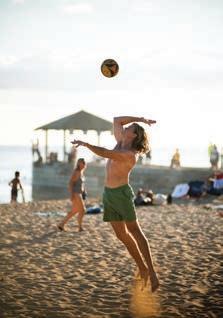
62
STORY
86 /
The Gods in Us
STORY
STORY BY DEREK FERRAR / PHOTO BY MIKE COOTS
DEPARTMENTS & FEATURES
28 / Watercraft 911
Ripped wings, caved-in canoes, buckled boards—if it’s broken, Hawai‘i’s fixers come to the rescue
STORY BY CATHARINE LO GRIFFIN / PHOTOS BY HAYDEN RAMLER
40
/ The Man Who Drew Hawai‘i
Since the 1970s, James Bier’s maps have shaped the way we see—and imagine—the Islands
STORY BY PETER VON BUOL /
PHOTOS BY TAYLOR GLASCOCK
50 /
A Tale of Two Ponds
A community unites the ancient fishponds of Loko Ea and ‘Uko‘a
STORY BY CATHARINE LO GRIFFIN /
PHOTOS BY GREG HATTON
60 /
Playing in the Sand
Waikīkī’s beach volleyball scene attracts players from around the world to the birthplace of the sport
STORY BY LUKE WAIKS / PHOTOS BY ELYSE BUTLER
72 / Eyes of the Kānaka Portraits of Moloka‘i’s People
PHOTOS BY PF BENTLEY
Kawai Strong Washburn’s debut novel captures the myths and realities of life in the Islands
STORY BY ANDERSON TEPPER / PHOTOS BY MEGAN SPELMAN
96 /La Maui Vita
Artist and bon vivant Piero Resta created a life—and an Italian villa—in the wilds of Kaupō
STORY BY JACK TRUESDALE / PHOTOS BY VIOLA GASKELL 110 /

/
Hawai‘i’s Wailele (Leaping Waters)
144 / Pau Hana
STORY BY STU DAWRS / PHOTO BY ARTO SAARI
ISLAND INTELLIGENCE 14 / Sustainable Snorkeling STORY BY DW GIBSON / PHOTO BY ELYSE BUTLER 16 / Little Rigs STORY BY MARTHA CHENG
PHOTO BY TOMMY
18 / The Architect’s Retreat
/
SHIH
PHOTO
20 / Cutting Class
BY MARTHA CHENG /
BY TOMMY SHIH
/ PHOTOS BY MEGAN SPELMAN Contents V25 N 0 4 AUGUST-SEPTEMBER 2022 02
BY MEGHAN MINER MURRAY
127
Hawaiian Airlines Information 142
Hana
Crossword
Island by Island & Events Calendar
/
Hou!
School of Stoke



MICROTRUCKS / Learn why, on O‘ahu, the popularity of so-called "bread loaf cars" is growing.

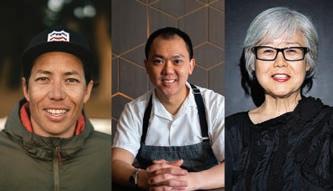 THE FIXERS / An integral part of Hawai‘i, they step in when "Mickey Mouse repairs" to watercraft won't do.
B-BOYS / Breakdancing is making a comeback in the Islands. Meet the crews.
ALOHA GOES BOTH WAYS / A video series exploring locals who embody the aloha spirit both at home and afar.
THE FIXERS / An integral part of Hawai‘i, they step in when "Mickey Mouse repairs" to watercraft won't do.
B-BOYS / Breakdancing is making a comeback in the Islands. Meet the crews.
ALOHA GOES BOTH WAYS / A video series exploring locals who embody the aloha spirit both at home and afar.
04 tv Find more hana hou! videos, stories and events on nmgnetwork.com Instagram: @hanahoumag Facebook: /HanaHouMagazine
PHOTOS BY JOSH LETCHWORTH, EVAN SUNG, ELI SCHMIDT

PUBLISHER & CEO
Jason Cutinella
VP BRAND DEVELOPMENT
Ara Laylo
GLOBAL EDITORIAL
DIRECTOR
Brian McManus
EDITOR
Michael Shapiro
PHOTO EDITOR
Matt Mallams
DESIGNERS
Mai Lan Tran
Nico Enos
Taylor Niimoto
Eleazar Herradura
VP FILM
Gerard Elmore
FILMMAKERS
Blake Abes
Romeo Lapitan
Erick Melanson
VIDEO EDITOR
Jhante Iga
BRAND & PRODUCTION MANAGER
Kaitlyn Ledzian
BRAND PRODUCTION COORDINATOR
Taylor Kondo
OPERATIONS
PARTNER/GM —HAWAI‘I
Joe V. Bock
VP ACCOUNTS RECEIVABLE
Gary Payne
CREATIVE SERVICES MANAGER
Sheri Salmon
OPERATIONS MANAGER
Sabrine Rivera
ADVERTISING
ADVERTISING DIRECTOR
Simone Perez simone@NMGnetwork.com
DIRECTOR OF SALES
Tacy Bedell
tacy@NMGnetwork.com
HEAD OF SALES
Kristine Quine
VP SALES
Mike Wiley
VP GLOBAL BRAND STORYTELLING
Marc Graser
MARKETING & ADVERTISING
EXECUTIVE
Courtney Asato
ACCOUNT EXECUTIVE
Nicholas Lui-Kwan
CONTACT
EDITORIAL INQUIRIES editors@NMGnetwork.com
SALES INQUIRIES sales@NMGnetwork.com
CONTRIBUTORS
PF Bentley
Peter von Buol
Elyse Butler
Martha Cheng
Mike Coots
Stuart Dawrs
Derek Ferrar
Viola Gaskell
DW Gibson
Taylor Glascock
Greg Hatton
Catharine Lo Griffin
Malanie McLellan
Meghan Miner Murray
Hayden Ramler
Arto Saari
Tommy Shih
Megan Spelman
Anderson Tepper
Jack Truesdale
Luke Waiks
Published by: NMG Network
36 N. Hotel St., Ste. A Honolulu, HI 96817
©2022 by NMG Network, LLC. Contents of Hana Hou! are protected by copyright and may not be reproduced without the expressed written consent of the publisher. Hana Hou! assumes no liability for products or services advertised herein.
3375 Koapaka Street, G-350 Honolulu, HI 96819
Phone: 808-835-3700 Fax: 808-835-3690
Mailing Address: PO Box 30008 Honolulu, HI 96820
For questions related to travel, visit us online at HawaiianAirlines.com or contact us at any of the following numbers:
UNITED STATES / CANADA
1-800-367-5320
Monday-Sunday, 24 hours Text 38285 Monday-Sunday, 5:00am - 11:00pm HST
AUSTRALIA (61) 1-800-955-912
CHINA (86) 10-6502-6766
JAPAN
0570-018-011 Monday-Friday
NEW ZEALAND (64) 0800-449-415
AMERICAN SĀMOA (684) 699-1875
SOUTH KOREA (82) 2-775-5552
TAHITI (689) 40-866-000
CONSUMER AFFAIRS HawaiianAirlines.com/CAO
BAGGAGE INQUIRIES
1-866-389-6654 Monday-Sunday, 8:00am - 4:30pm HST
H awaiian M iles
For information on our frequent flyer program, please contact our HawaiianMiles Service Center Monday-Friday, 7:00am - 4:30pm HST 1-877-HA-MILES or 1-877-426-4537
HAWAIIAN AIR CARGO INQUIRIES
1-877-422-2746
HawaiianAirCargo.com

ON THE COVER
Beyond the Dusk
Volleyball matches continue into the night at Queens Beach, Waikīkī
06 V25 N 0 4 AUGUST-SEPTEMBER 2022
PHOTO BY ELYSE BUTLER


“We were in the honeymoon phase, me falling in love with my brand-new, one-man canoe ”
One morning after a big rain, the water was brown, but I paddled out anyway. There was a big splash next to me, and a turtle dove down, leaving a nickel-size hole in my hull,” says Catharine Lo Griffin, explaining how her idea for “Watercraft 911” came about. “I panicked. I cried. I cursed. My friend texted me a contact—‘Mike Canoe Repair.’ I called, and a gentle voice said, ‘Bring it to my house.’ I drove there straightaway.” Within fortyeight hours Mike Soule had fixed the boat, Catharine was back in the water and order in her universe was restored. “Only a paddler knows the feeling,” she says, grateful to backyard fixers everywhere. Lo Griffin is a frequent contributor to Hana Hou!

“It’s not often that I stop and linger in front of a house in the boonies of Kaupō,” says Jack Truesdale, who wrote “La Maui Vita” about Italian artist Piero Resta for this issue.
“But I’d driven by Piero’s curiously adorned gate frequently enough and was starting to regret not finding out what lay beyond it—that feeling after passing by an intriguing stranger without exchanging a word, or not mustering the courage to walk down a mysterious street … in other words, curiosity.” After an internet search revealed the home once belonged to Resta, Truesdale knew there must be a story there. Truesdale lives on Maui and has written for Honolulu Civil Beat, Stab, Brown Alumni Magazine and Maui Times. This is his first piece for Hana Hou!

“With the highest number of Hawaiians per capita of any island, Moloka‘i lives the Hawaiian culture every day,” says photographer PF Bentley, whose ongoing “Face of Moloka‘i” project, featured in “Eyes of the Kānaka,” has been a labor of love to the island he calls home.
Taking inspiration from portraits by renowned photographer Richard Avedon, Bentley travels the island with his portable outdoor studio to photograph Moloka‘i residents. After growing up in Waikīkī, Bentley arrived in Moloka‘i in 1971 while a student at the University of Hawai‘i at Mānoa. “I was an urban kid landing in this very rural Hawaiian environment, which I fell right into.” Bentley spent twenty years covering the nation’s political landscape for TIME before returning to the Islands to shoot without a suit and tie.

“Growing up in Hāna, we called the narrow, winding road through Kaupō to the other side of Maui ‘the back way,’” says Viola Gaskell, who shot “La Maui Vita” for this issue.
“Villa Tamarinda sat on the back way next to the aging Kaupō Store, and it always intrigued me with its colorful sculptures and Roman columns edging out from the greenery. Photographing the property felt like visiting a part of Kaupō’s past I had only heard stories of, when artist Piero Resta threw parties overflowing with Italian food and art. Photographing places like this, inventions of zeal, has been an enduring passion throughout my career, from high-rise homes in Hong Kong to remote hermitages in Japan and now—back on Maui—to the places I wondered about years ago.” Gaskell has photographed and written for many publications including VICE, Vulture Magazine and Maui Times.
Contributors
Catharine Lo Griffin
Jack Truesdale
08
PF Bentley Viola Gaskell

Connecting Flight

Our Kuleana
If you are lucky enough to call Hawai‘i home, you know it’s a special place. If you are lucky enough to visit the Aloha State, you know why Mark Twain famously called Hawai‘i “the loveliest fleet of islands that lies anchored in any ocean.”
We agree, and that’s why each year we measure our progress in keeping our Island home a special place for residents and visitors while also ensuring that our company continues to be a desirable place to work. We call it our Corporate Kuleana Report. One way to translate “kuleana” is as a responsibility to others, and the report tracks the targets we set for improving our environmental, social and governance (ESG) impact.
What does that mean for Hawaiian Airlines in practical terms? It means reducing our environmental footprint, enhancing our contributions to the economy and strengthening our diversity, inclusion and belonging initiatives. For example, to address plastic pollution we have pledged to replace 50 percent of the single-use plastics in our cabins with sustainable alternatives by 2025 and to
phase them out completely by 2029. As a means to that end, we recently rolled out a pilot project that we expect will annually replace about 142,000 plastic bottles served onboard with aluminum bottles from Mananalu, a water company founded by Hawai‘i environmental activist and actor Jason Momoa.
Food sustainability is another important issue for us. Local sourcing boosts Hawai‘i’s economy and reduces greenhouse gas emissions associated with transporting food. In the last few years, our spending on locally sourced in-flight food and beverage products at our Hawai‘i hubs has grown to 29 percent. By 2025, we want to increase this spending to 40 percent. We have also committed to using cage-free eggs for catering on all flights departing from Hawai‘i by 2025 and on all domestic flights by 2027.
Other kuleana goals are more farreaching, part of our contribution to the global fight against climate change. We are committed to achieving netzero carbon emissions by 2050 and are exploring sustainable aviation fuel opportunities while also preparing to induct fuel-efficient Boeing 787-9 aircraft as soon as next year. We are
BY PETER INGRAM , PRESIDENT AND CHIEF EXECUTIVE OFFICER, HAWAIIAN AIRLINES
also partnering with Conservation International to offer a carbon offset program for guests while committing to offset emissions from all employee business travel on our aircraft. Achieving our carbon emission goals depends to some extent on technology that doesn’t yet exist at commercial scale, but we must nevertheless move forward and make progress toward our destination.
Our kuleana also extends to the broader visitor industry, in which we continue to partner with grassroots, industry and political leaders to shape a greener, more beneficial and equitable tourism economy. If you have traveled aboard one of our trans-Pacific flights, you have seen the Travel Pono (responsibly) in-flight video we created last fall. It explains how to safely enjoy the Islands while respecting our communities, culture and environment.
The heart of Hawaiian Airlines will always be our people, and our team once again answered the call to help those in need. Nearly 1,000 Team Kōkua employee volunteers donated 3,100 hours to community causes in 2021. We supported more than 40 nonprofits with 14 million HawaiianMiles, half of which were generously contributed by our loyalty members.
While we still have much work to do, I am encouraged by our progress. I could not be prouder of the entire Hawaiian team for making us a better airline for each other, our guests and the communities we serve.
Finally, I would be remiss if I didn’t mention that this magazine is undergoing an evolution of its own. Regular readers of Hana Hou! will notice a new look. What isn’t changing is the focus on thoughtful storytelling about the people and places of our beloved fleet of islands.
From our ‘ohana to yours,
10
Last year, Hawaiian Airlines employees volunteered more than three thousand hours of their time to community causes. Caring for Hawai‘i’s natural resources, like the water flowing down O‘ahu’s Lulumahu Falls (seen above) is a major component of this commitment to the Islands we serve.
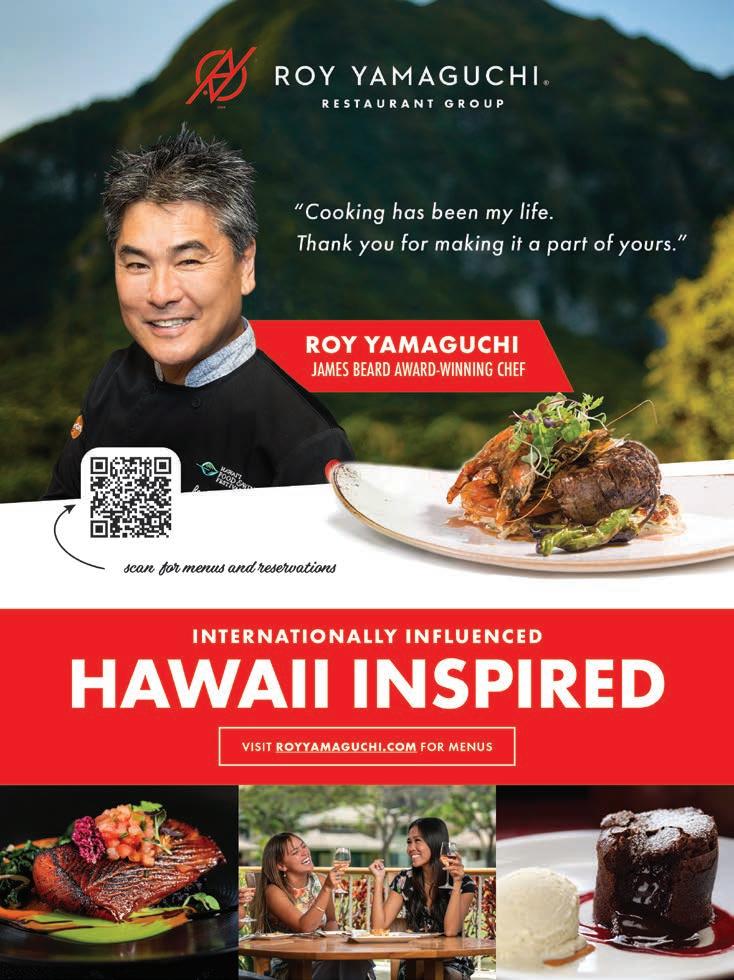


island intelligence
Sustainable Snorkeling
“Just because it says ‘reef safe’ does not mean it’s safe for this reef,” says Dant, pointing toward the topaz waters off Kealakekua, where Fair Wind’s vessels anchor for four-hour snorkeling tours.
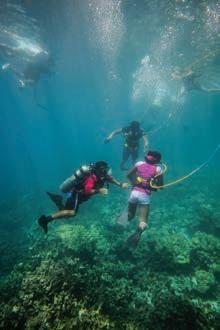

It’s hard to keep the “eco” in ecotourism when you’re running two snorkel tours a day from a pair of sixty-foot boats, but the Dant family aims to set a high bar with Fair Wind Cruises. “A lot of tour operators have good intentions but don’t see themselves as the problem,” says Alex Dant, who oversees Fair Wind’s day-to-day operations. “But it’s our gasoline, our plastic water bottles and Mylar bags. We need to make every possible change to minimize the impact we have.”
Dant’s grandparents started Fair Wind on Hawai‘i Island in 1971, and for the past forty years it’s been a family-run operation. Thirteen years ago, despite his father’s worry that it’d sink the business, Dant switched to biodiesel for their vessels—with Dant chasing down tempura oil from
Japanese restaurants before he found a distributor. More recently the company traded plastic bottles for reusable cups, and they encourage guests to cover up rather than lather on sunscreen, even if it’s labeled “reef safe.” “Just because it says ‘reef safe’ does not mean it’s safe for this reef,” says Dant, pointing toward the topaz waters off Kealakekua, where Fair Wind’s vessels anchor for four-hour snorkeling tours. But they didn’t stop at these basic steps.
In 2008 the Dants invested in an eight-acre coffee farm about a mile from where their vessels dock and started serving their coffee on excursions. They also started a composting program, going from eight bags of trash a day to one partial bag—all while bringing as many as sixty thousand visitors a year to sensitive reefs off the Kona coast.
When COVID-19 hit, the Dants bought five additional acres to cultivate crops like papayas, bananas, sweet potato, jackfruit and ‘ulu (breadfruit), allowing them to do the unthinkable to their famed lunch menu. “We’ve gone from serving one hundred cheeseburgers a day to all plant-based food,” Dant says. “This is not a small thing.” Alex recalls the 70-year-old cattle rancher who was “not so cool with it at first, but before he left the boat he came to me and said, ‘I did not want to say this, but I really liked the food,’” he laughs. “At moments like that you can take a breath and say, ‘OK, at least we didn’t do anything wrong.’”
BY DW GIBSON PHOTOS BY ELYSE BUTLER HAWAI‘I ISLAND INTELLIGENCE
STORY
FAIR-WIND.COM 14
Fair Wind Cruises’ vessel Fair Wind II anchors in Kealakekua bay (seen also on the previous spread) for one of its daily snorkel tours.
 STORY BY MARTHA CHENG
STORY BY MARTHA CHENG
Little Rigs
“People are just like, ‘Oh my gosh, what is that? That’s so cute!’ Because Hawai‘i has such a strong connection to Japan, a lot of people have seen these cars in Japan, and they want to take a second look.”

Maybe you’ve been seeing more of them around town: tiny trucks and vans from Japan, sometimes nicknamed “bread loaf cars” for their boxy shape. There’s the mint-green 1995 Subaru Sambar nicknamed “Sue Brew” parked outside Honolulu Coffee
Co.; Justin Park’s 1994 Suzuki Carry shuttling between his businesses, Bar Maze and Bar Leather Apron; and TK Yamada’s 1992 Suzuki Carry—a.k.a. “TinyTim”—carting pastries and coffee to his café, Try Coffee. Business owners in particular love the microtrucks for the
way they can squeeze into Hawai‘i’s old parking lots and tight spaces, and they’re easier to load because the bed is lower than a standard pickup truck’s and all the sides fold down.
But also: They’re fun. “It’s exhilarating to drive—the way you’re seated above the front tires makes it feel like you’re flying,” Yamada says. Because the trucks are manufactured in Japan, the steering wheel is on the right, which leads to confusion and occasional hilarity. “Whenever I drive around with my friend’s dog, and I’m on the right and the dog is on the left, it’s fun hearing, ‘Is that dog driving?!’ as I cruise by people on the street.”
Brandon Dobbs, who owns a 1995 Honda Acty microvan, which he says is perfect for camping because the back seats fold flat, gets stopped at least once a day when he’s driving it. “People are just like, ‘Oh my gosh, what is that? T hat’s so cute!’ Because Hawai‘i has such a strong connection to Japan, a lot of people have seen these cars in Japan, and they want to take a second look .” Dobbs says his obsession with cars sta rted with the movie Back to the Future. “Marty McFly’s super awesome black Toyota pickup … that was always the holy grail of trucks.” But what about the DeLorean? “Yes, and the time machine, too,” he says as an afterthought.
In early 2021, Dobbs started Pacific Import Vehicles, which specializes in bringing microvans and microtrucks to Hawai‘i. Business has jumped in the past year—he now fields about ten requests per month—and he just finished an interview with a Japanese morning show, “because people in Japan are becoming aware of Hawai‘i’s fascination with these little trucks. They think it’s funny we’re so enamored with them.”
PHOTOS
O‘AHU INTELLIGENCE
BY TOMMY SHIH
16
TK Yamada relaxes aboard “TinyTim,” his 1992 Suzuki Carry, one of the “microtrucks” imported from Japan lately appearing on Hawai‘i’s roads.
 STORY BY MARTHA CHENG
BY TOMMY SHIH
STORY BY MARTHA CHENG
BY TOMMY SHIH
The Architect’s Retreat
“It’s hard to describe objectively,” says Valerie Ossipoff, Vladimir’s daughter, of her time there, “because it was a feeling place. You just came and you were quiet. It was never noisy, ever.”
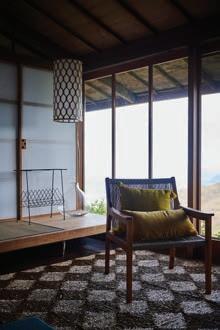

On a rarely visited ridge on O‘ahu are the little-known cabins built by Hawai‘i’s most famous architect, Vladimir Ossipoff. Pālehua is an hour’s drive west from Honolulu, half of it climbing steeply up a ridge to 2,500 feet, where the heat and the smell of asphalt give way to the cool air and bracing scent of eucalyptus. Entering the main cabin, you suddenly feel as though you’re hovering over the edge of the mountain, the Wai‘anae range and the entire Leeward coastline unfolding before you.
Ossipoff built the first cabin in the early 1950s as a weekend retreat for his family, and a second, smaller one about five years later for close friends. They are among the few projects still standing that he designed and built for himself. The cabins were “his test bed, his sketchpad,” says architect Graham Hart. Compact and minimalist, their layout parallels the prevailing trade winds.
The details—rough-hewn strawberry guava and eucalyptus wood posts, screened sliding walls, narrow strips of window at eye level—illustrate some of Ossipoff’s signature design principles: the integration of inside with outside, the contrasting shadows and light, the organic relationship to the site. The understated cabins seem only to lead the eye to the expansiveness beyond. “It’s hard to describe objectively,” says Valerie Ossipoff, Vladimir’s daughter, of her time there, “because it was a feeling place. You just came and you were quiet. It was never noisy, ever.”
After Ossipoff relinquished his lease and left the cabins in the 1970s, they fell into disrepair. Then in 2009 the Gill family acquired nearly 1,600 acres at Pālehua from the Campbell Estate, with the goal of cultural and environmental conservation; about five years ago they began restoring the
cabins based on archival photos from the ’60s, enlisting craftspeople to sand down the cabins’ unfinished wood and create a facsimile of the original, from the hand-cut lampshades to the MidCentury Modern furniture. The family is making the cabins available to those who invest time doing conservation work in the Wai‘anae mountains. Gary Gill hopes that when people step into the cabins, they will come to appreciate what Ossipoff understood: how unique Hawai‘i’s environment is, he says, “how precious and how it needs our time and attention to protect it.” PALEHUA.ORG
O‘AHU INTELLIGENCE
PHOTO
18
 STORY BY MEGHAN MINER MURRAY
STORY BY MEGHAN MINER MURRAY
Cutting Class
“I knew I wouldn’t fit into [traditional] Japanese culture,” he says. “I like doing what I want.”


As a boy in Sanjo, Japan, Hiko Ito recalls the din of hammers and the smell of forge fires as he walked to school. “The town was known for metalwork,” Ito says. Traditional values were so much a part of the local culture that “in preschool little kids had to learn how to fight with bamboo swords … and to learn tea ceremony and meditation.” While it seems fated that the 49-year-old would become a knifemaker, he once ran from the heritage he now embraces, and he came to it sideways, out of necessity.
Ito left Japan at 19, enrolled at Southern Illinois University and never looked back. “I knew I wouldn’t fit into [traditional] Japanese culture,” he says. “I like doing what I want.” He wanted to be close to the ocean, so after graduation he moved to California to study oceanography at Humboldt State University. With his newfound passion for rock climbing, he often wound up inland, living simply in the desert near Joshua Tree. But he missed the ocean and yearned to live in the tropics. Thus, Ito came to Hawai‘i, where he learned to freedive and live off the land by spearfishing and hunting. It was then, when he needed a good hunting knife, that he started crafting his own—“Good
HAWAI‘I ISLAND INTELLIGENCE
PHOTOS BY MEGAN SPELMAN
20

V knives are expensive!” he says—teaching himself through trial and error, and by watching YouTube.
Ito discovered both a passion and aptitude for knifemaking. “Once I get into it, I go all in,” Ito says. Friends and fellow hunters were impressed with Ito’s clean but elegant design and wanted a knife of their own. “I don’t want to make anything that’s not functional,” Ito says. “I like simple, user-oriented design.” Demand grew, so Ito started selling his knives, structuring production in much the same way metalsmiths creating kitchen cutlery and farm tools in Sanjo have for centuries. He buys many of his machined forms from the East Coast; these are heat-treated by someone else in Idaho. He employs two more people to sell his knives at the Waimea Farmers Market on Saturdays. But Ito is the artist, the craftsman designing, shaping and finishing each blade. He’s made thousands of hunting, chef and everydaycarry knives over the past fifteen years, imprinting the blades with his name in katakana characters along with the knives’ provenance in English: Hawai‘i.

HIKOITO.COM
STORY BY MALANIE MCLELLAN
PHOTO BY ELYSE BUTLER
Green Space
“It’s so rewarding to have people come in and pick what they’re drawn to. There’s a plant for everyone. We offer plants for people that don’t have a lot of time, plants that are
safe for pets, plants for people with children or with limited space. The list goes on.”

There’s an oasis hidden in the hot, dry, bustling urban landscape of Kaimukī. You might not notice it from the street, but traverse the scorching pavement to the second floor of Lafite Plaza, and you’ll find a charming nursery/ café. Entering Plantoem feels like stumbling upon a spontaneous rainforest, part garden, part coffee shop. Patrons lounge, read and compute among the verdure in the breezy café, sipping yerba maté and lavender spritzers to strains of jazz. The work of up-and-coming Island artists adorns the walls. It has the feel of what coffee shops were like before the big chains came to town—if said coffee shop were in the Amazon.
The name Plantoem, a portmanteau of “plant” and “poem,” illustrates what founder Zoe Zhang set out to create: a relaxed, verdant environment for the community, one that fosters creativity and blends her two favorite things, plants and poetry. The green-thumbed Zhang began selling plants online when the pandemic hit, and was so successful that she decided to open the shop. “I had no idea people loved plants as much as I do,” she says.
With scores of rare and beautiful indoor plants (some current favorites
O‘AHU INTELLIGENCE
22
Proprietor Zoe Zhang at Plantoem, the nursery/café in Kaimukī fusing her twin passions for poetry and plants.
include the Thai Constellation Monstera, Pink Princess Philodendron and Living Stones), Plantoem is a place for both beginning and advanced plantsmen (yes, that’s a word) to discover and acquire new greenery. “Plants are like people— they have their own personalities,” Zhang says. “It’s so rewarding to have people come in and pick what they’re drawn to. There’s a plant for everyone. We offer plants for people that don’t have a lot of time, plants that are safe for pets, plants for people with children or with limited space. The list goes on.”
Plantoem hosts monthly jazz and poetry reading nights, yoga classes, a terrarium workshop where kids learn to make their own tiny forests (Zhang says some of her most enthusiastic plant people are as young as eight), and pop-up events influenced by customer interests—like tango lessons, painting classes and an upcoming poetry workshop for kids. And, of course, classes on how to care for plants. The schedule of events, along with striking photos of current plants for sale, can be accessed via Plantoem’s Instagram.

@PLANTOEM
STORY BY DEREK FERRAR
COOTS
The Surf Grove
“After you start going a certain speed, lighter foam-core boards start to shudder and want to lift up,” he explains. “The heavier, stiffer wood just calms everything down.”

As a wave-obsessed young surfer in Honolulu in the 1960s, waterman Terry Chung’s beloved first surfboard was an old balsa-wood cruiser that his family bought off a neighbor. Four decades or so later, Chung—having become a big-wave legend and elite
shaper on Kaua‘i’s north shore—worked alongside his buddy Laird Hamilton to pioneer the new style known as foilboarding. (So named because a hydrofoil underneath the board lifts the rider out of the water, a sensation Chung likens to being “a seabird skimming over
the top of a wave—no resistance at all.”) Chung helped spark today’s foilboarding craze, thanks to an eyepopping sequence in the 2011 film A Deeper Shade of Blue that featured him swooping above massive azure swells. But as foiling evolved, he found that regular foam-core boards were too light and flexy for the heavy-duty tow foiling he and his buddies were doing in the big stuff. So he returned to his first love: balsa. “After you start going a certain speed, lighter foam-core boards start to shudder and want to lift up,” he explains. “The heavier, stiffer wood just calms everything down.”
After experimenting unsuccessfully with local woods, Chung ordered a batch of balsa lumber from Ecuador and began crafting boards from strips of the soft, buoyant wood. Then one day a surfing buddy laid a handful of balsa seedlings on him, so Chung planted them on his six-acre property in Kīlauea and spent the better part of a decade watching them grow, gradually adding dozens more. “Each board literally takes years to build, since you have to grow the wood first,” he says. When the trees reach about a foot and a half in diameter—after seven years or so—he mills them into planks and “forgets about” them for another a year or so, until they’re dry enough to become surfboards.
Because of the effort involved and his limited supply, Chung generally reserves his homegrown boards for his tight-knit crew of Kaua‘i tow foilers and friends scattered around the world’s XXL surf meccas. Not that he dwells on it much, but every now and again after finishing a ride, he says, “the thought comes to your mind: ‘Man, this board—I grew it, I built it and now I’m riding it.’ That’s pretty cool, you know?”
KAUA‘I INTELLIGENCE
PHOTO BY MIKE
24
@KAUAI_SURFBOARDS
Kaua‘i shaper Terry Chung with one of his balsa-wood boards, created from trees he grew on his property in Kīlauea.



departments & features
Watercraft 911
Ripped wings, caved-in canoes, buckled boards—if it’s broken, Hawai‘i’s fixers come to the rescue.
One windy day on the North Shore of O‘ahu, Derek Hamasaki misjudged his approach to an overhead wave. The foil surfer tried to correct, but too late: The wave crashed on him, twisted his foil and sent him flying over his wing—a wide, bat-shaped kite with handles and an inflatable edge, the surfing world’s latest fancy of flight. Before he could escape the whitewater, the next wave caught him. As Hamasaki and his gear tumbled, the foil sliced through almost the entire length of the $1,000 wing. “Small mistakes can cause catastrophe,” he says, acknowledging the struggle—and danger—of paddling broken equipment to shore in heavy conditions. Later he recounted the ordeal to fellow wingers in a group text:
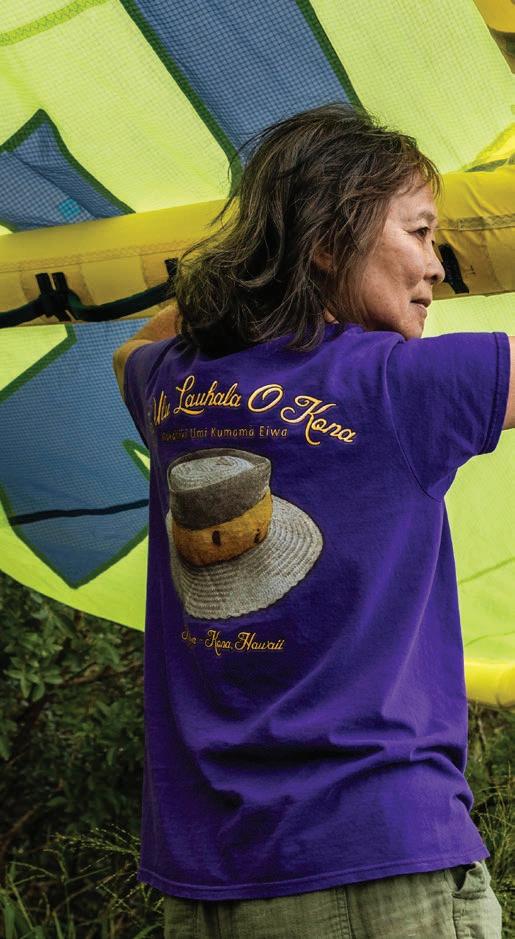
STORY BY CATHARINE LO GRIFFIN PHOTOS BY HAYDEN RAMLER 28
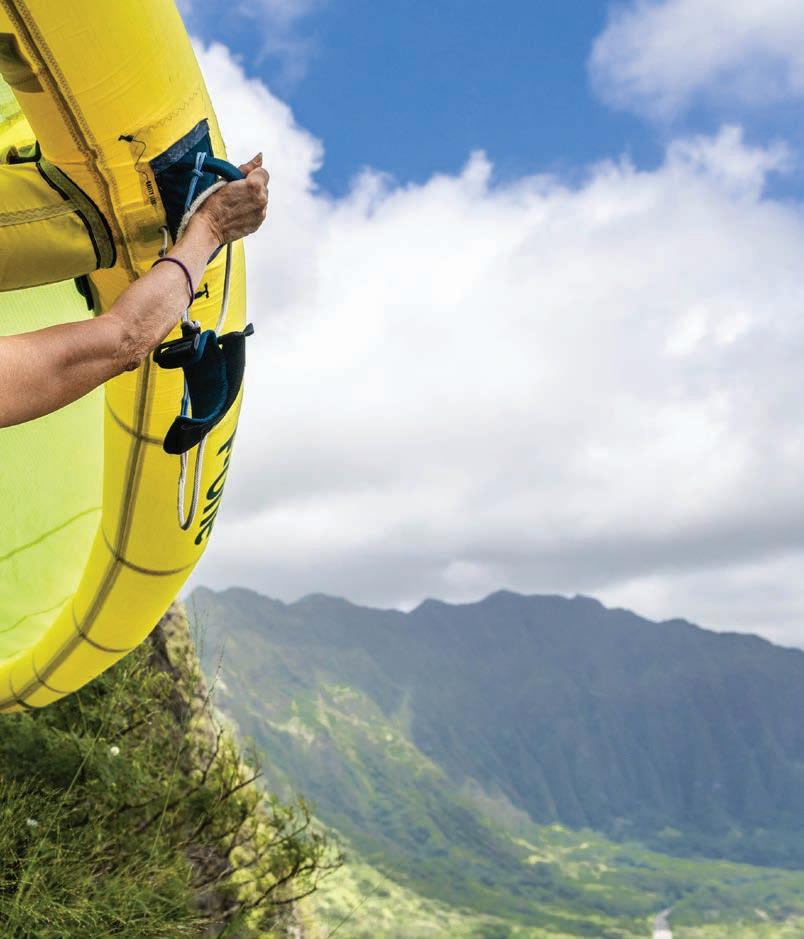

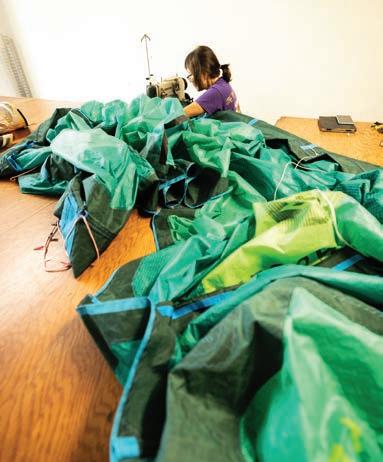
“Guess what?” he wrote, “Gotta go visit Auntie Brenda again!”
Accidents happen. Sometimes it’s user error—ram into another board, whack a wall rounding a corner, forget to strap your vessel to your roof racks. Other times, it’s misfortune: Wildlife collides, waves pummel, reefs slash. The lightweight materials in modern watercraft are relatively fragile, and well-used equipment inevitably takes a beating.
Brenda Ching is the one woman whom every wind, wing and kite surfer has in their contacts. Typically she’s listed as “Brenda, kite fixer” or “Brenda, wing repair.” She might as well be “Brenda, fairy godmother,” because with a wave of her arms (and two industrial sewing machines), she turns tattered pieces of fabric back into highperformance kites. The small-framed, soft-spoken Nu‘uanu seamstress belongs to an unsung club of behind-the-scenes fixers who undo the damage done to Hawai‘i’s favorite water toys: boards, wings, kites, sails and canoes.
“A lot of people will text me pictures and ask, ‘Can you fix this?’” Ching says. Unless the sail or wing or kite is too old to be worth mending, her answer is usually, “Yes, yes. I can fix that.” She spreads the casualties out on an eightby-fifteen-foot table in what used to be her living room, measuring and marking giant folds of fabric. Years of wrangling heavy canvases through the sewing machines have taken a toll on her shoulder, so she avoids working on large sails. Her garage is strewn with rolls of polyester, nylon, Dacron and other materials to keep up with the rapidly evolving industry.
Ching learned to make and repair sails in the ’80s under the tutelage of Tom Nishimura, creator of Vortec Sails. After he died, she continued. With the advent of kite surfing in the ’90s and wing foiling over the past few years, a new generation of dispirited watermen and women has sought her out. Drawing on her own experience as a windsurfer, Ching fixes the most stubborn tears in
the trickiest of places, often applying solutions that come to her in her sleep. She has also adopted Nishimura’s meticulousness: “He would change things like, a tenth of an inch,” she says. Those new to wind sports are Ching’s most frequent customers. “Some guys haven’t even gotten in the water yet—they launched from the beach and the kite went boom! Straight into a tree,” Ching says. “That’s really heartbreaking for everybody, especially if it’s a new kite.” After their first accident, Hamasaki says, some guys will try to duct tape or hand-sew a kite. “Your Mickey Mouse repair might fly for a little while, but then you realize no, this is not working. When you take it to Brenda and see the way she does it and how fast she turns it around, you go, ‘I’m coming here every time.’”
Because she works from home and because there are so many mishaps, Ching has to set boundaries. “I want a weekend. I have to take dinner off,” she insists. But she understands how much
30
Seamstress Brenda Ching (seen also on the previous page) repairs a torn kite in her Nu‘uanu workshop. “Auntie Brenda” is one of a cadre of in-demand repairers with the expertise to keep Hawai‘i’s watermen and women doing what they love.
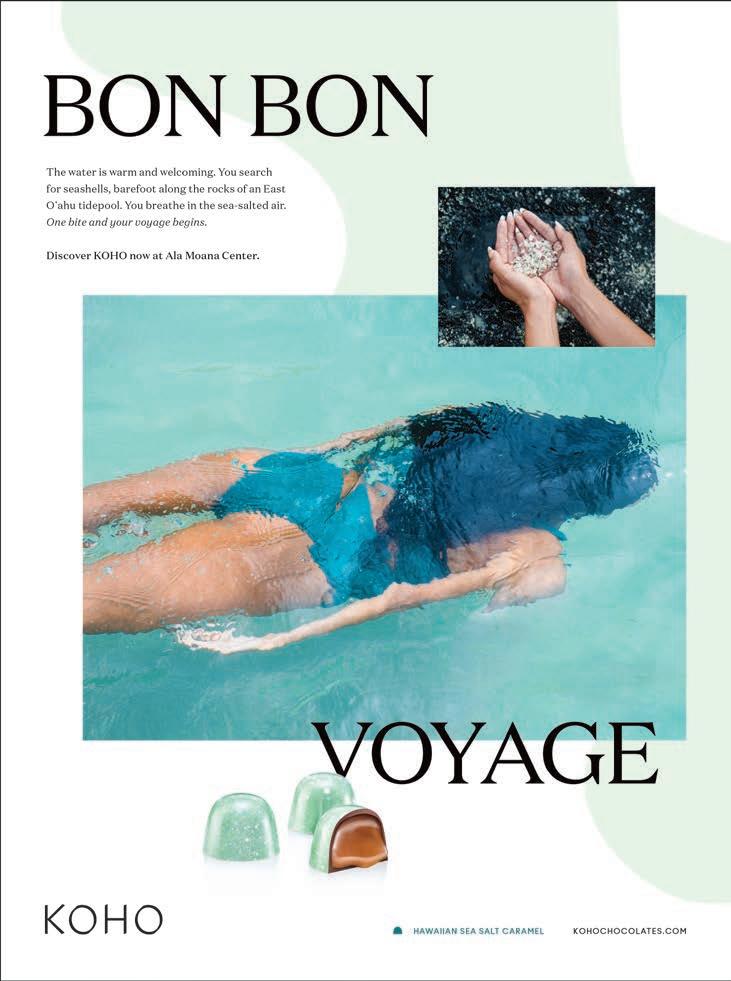


her customers appreciate her dedication. “I don’t want to be the cause of someone not having fun. I don’t want to go to the beach and hear anyone say, ‘My kite’s in the shop.’” She even schedules her vacations for periods when there’s likely to be no wind. When she leaves town the group texts blow up: “Brenda’s going on vacation! Don’t do anything crazy.”
Despite the relentlessness of the work, Ching says she has no plans to retire. “The fun part is handing it back and seeing the smile on their faces when they say, ‘Wow, now I can go back out again!’”
Two days before the National Scholastic Surfing Association’s regional championships last May, rising star Nalu Deodato was practicing at Kewalo’s, the contest site and surf break on O‘ahu’s south shore. He launched an aerial off the lip and landed hard, buckling the 5’8” Tokoro he was planning to use. Next morning, he rushed it over to Dan Franzmann—a.k.a. “Dano”—who fixed it and had it back to
him that night. Deodato paddled it out and won the Open Juniors division.
Nalu’s predicament isn’t unusual, says Dano, who’s earned a reputation for fixing boards fast and well. Though surfboards are shaped from a standard blank, pros are sensitive to the tiniest differences, even the density of the foam in specific parts of the board. “If the board feels magical, they’ll ice it. They’ll hold that board, and the day before the contest they’ll break it out. They just want to get a wave or two, feel it out. Then, doh! They buckle the board.”
In between surfing and studying English at Brigham Young University in Lā‘ie, Dano would hang out at Race Hawaii Surfboards in Hale‘iwa. Owner Scott Bucknell taught him how to work with fiberglass and resin, and he helped repair boards for the shop. The charismatic, self-described hustler soon generated his own business, fixing boards for renowned surfers like Jock Sutherland and Mark Foo, for customers of Hawaii Surf & Sail and for
backpackers at Foo’s hostel. That was back when a gallon of resin was $10 (today it’s $50), he recalls. When Dano’s parents cut him off because he took too long to finish college, ding repair paid the last year and a half of his tuition.
At 33, Dano decided he needed to make something happen. He and his wife took out a loan, moved to Vegas and opened a Wyland art gallery. “All of a sudden I had the weight of the world on my shoulders, whereas before it was just, ‘Am I gonna surf in the morning, or should I wait till after lunch?’” he says. “It was super stressful but things turned out pretty well.”
In 2003, the couple moved back to the North Shore and had two sons, Dylan and Makana. By the mid-2000s they were operating ten galleries in Vegas, Lake Tahoe and Hawai‘i. When their marriage ended, Dano traded his opulent lifestyle for a simpler one. He surfed with his boys, who became competitive. When they dinged their boards, naturally, he fixed them—and
32
“In this life your ding repair guy is just as important as your plumber, your electrician or your handyman,” says North Shore surfboard surgeon Dan “Dano” Franzmann (seen above), who fixes many of the dinged, buckled and broken boards claimed by Hawai‘i’s ferocious surf.
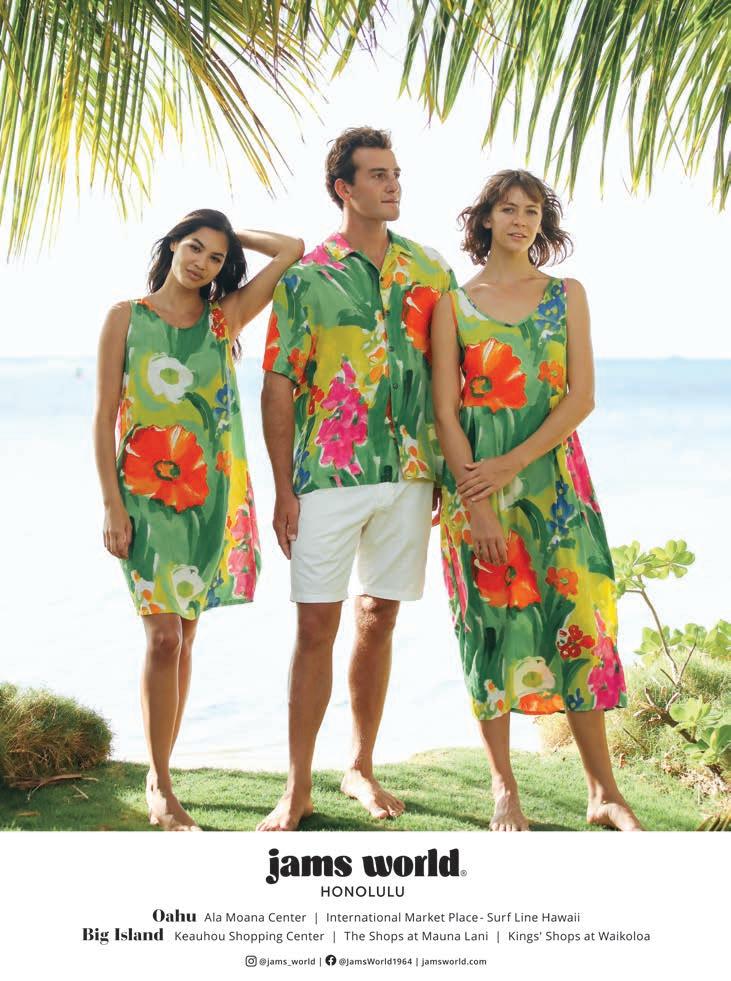

The no-nonsense entrepreneur also won’t brook entitlement. “I will fire people who act like they’re my only customer after I’ve just told them, ‘Hey man, I got fifty boards here and I’m three weeks back.’ If they act selfish, I’ll tell them, ‘Hey, take your board. Beat it.’ I’m like the soup guy on Seinfeld. ‘You complain? No repair for you!’”
“Dano is the rare combination of good businessman and good ding repair guy,” says surfboard shaper Jon Pyzel, explaining why he entrusts Dano with the quivers of his team riders (including that of two-time world champion John John Florence). “Your boards end up in good condition, and they are finished when he says they’ll be, making the few extra dollars spent well worth it.”
Now 58, Dano’s teaching his son Dylan how to fix boards—a dying art, he says, thanks to YouTube’s many subpar instructional videos. It’s not always a glamorous job—“It stinks. The dust makes you itch. There’s a reason no kids are pulling on your shirttail to get into it,” he says—but the appreciation is his reward. “I have the world’s best customers, who hug me because I fix their toys. They bring me beer, food, pies, tips. When I’m riding down the bike path, people will yell, ‘Dano! Thanks for fixing my board!’ There’s a saying: ‘You have the power to be happy by making other people happy.’ I didn’t know that as directly as I do now,” he grins. “I groove on it every day.”
“It was that ‘one day’ everyone worries about,” recalls Lili Taliulu. “I got caught by a wave at Papa‘iloa and lost my paddle. Then I smashed the nose of my canoe in the shorebreak swimming it in. A guy walking the beach helped me carry it almost two miles back to the canoe club. I was heartbroken but escaped with only a couple bruises and a sore body.”
before long he was fixing others’ boards as well. “In this life your ding repair guy is just as important as your plumber, your electrician or your handyman. I try to make the money those guys make, but I don’t do it by gouging people,” says Dano. “I do it by lining everything up and being super productive.”
A true North Shore original, Dano doesn’t advertise and he’s not on social media, though you can usually find him on Fridays and Mondays in Honolulu at
Moku Hawaii surf shop. “I don’t Venmo. I don’t PayPal. It’s all cash and carry,” he says. “I don’t have one dollar of debt in my company. I don’t have anyone owing me money. I’m not in the bill collector business. I’m not in the board storage business—if I text someone that their board’s done and days go by, I sometimes threaten $10 a day storage. They come running.” The tactic works: So far Dano hasn’t actually had to charge a storage fee.
Taliulu sent photos of the wreckage to Mike Soule, a retired construction manager who repairs one- and two-man canoes. He called back immediately and asked whether Taliulu were all right. “Canoes can be fixed,” he’d said. A couple weeks later, Soule had made the carbon fiber shell watertight and camouflaged the damage with a spiffy paint design. “Mike understands the connection we have with our canoes,” Taliulu says.
34
Canoe repairman Mike Soule examines an ama, the float of an outrigger canoe.
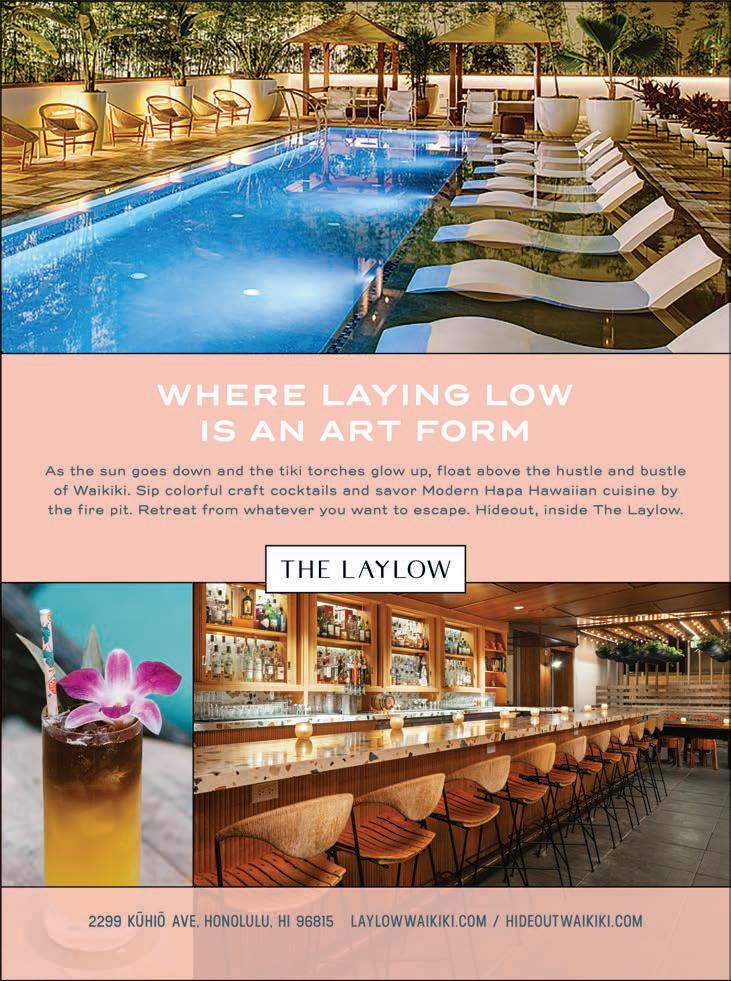

That understanding comes from decades of experience working with building materials like fiberglass, coupled with his recently discovered passion for paddling. As an avid surfer, Soule also became adept at fixing boards. After weekend surf sessions, he would help his friend at Island Glass Surfboards shape, glass, sand and
polish boards. Repairing canoes was a logical segue once he started paddling.
Not long after Soule joined New Hope Canoe Club in 2016, his coach Cy Kalama was grumbling about not being able to get anyone to fix the equipment. Soule asked, “What you like fix?”
Kalama showed him a four-hundredpound fiberglass canoe with a shattered
nose. “I think I can fix ’em,” Soule said. Kalama eyed him skeptically before telling him to give it a shot. That was a Tuesday, and by Saturday’s practice the repair was done. “Cy goes, ‘You did that?’” Soule says. “‘I got a lot more things for you to fix.’”
From cracked ama (outrigger canoe floats) to a $25,000 racing canoe that
36
Good as new: Foiler Derek Hamasaki catches air on the North Shore of O‘ahu after Brenda Ching repaired a three-foot-long gash in his $1,000 wing (seen on the facing page, bottom) Facing page, top: Ching rolling up a windsurfing sail.
BY PETER KING
PHOTO


had broken into four pieces, Soule has helped multiple canoe clubs shore up their fleets. Without realizing it, he was paddling in the wake of master craftsmen Clay Carson and Brent Bixler, the sport’s go-to fixers. Mike’s number became the 911 for one-man canoe paddlers, like his friend who crunched his wife’s ama while she was off-island. “I wasn’t supposed to take the boat out!” he panicked, calling Soule for help. “Bring it to my house,” Soule told him, always keen to put out fires.
Soule likes to wake up at 3:30 a.m. Six days a week, he hits the gym. After breakfast he’ll work on boats until lunch. If parts need to dry out or resin has to cure, he’ll go for a surf or a paddle. The fixes can be tedious, depending on the damage. “Carbon fiber is strong till it gets hit. It has a certain amount of rigidness and a little bit of flex. But once you break that threshold, it’s just like getting a crack in a windshield—it keeps growing. So you gotta follow all the shatter marks till you get ’em out,”

 PHOTO COURTESY DEREK HAMASAKI
PHOTO COURTESY DEREK HAMASAKI

he says. Besides the hull’s integrity, there are cosmetics to consider, which is particularly challenging because most OC1s are painted in China. “If the paint doesn’t really match, it looks like hell.”
During the pandemic, when so many people took to the water, Soule’s yard was like a triage ward. Even though he doesn’t advertise and gets business
through referrals, repairs dominated his schedule seven days a week for months. Nowadays he tries to maintain a more manageable project list. His compassion still wins out, though, and he toils to get boats back to their owners quickly. “For some people their canoe is a real big thing. It’s their outlet,” says Soule. A new OC1 runs about $5,000, and high
demand means a six-month wait before orders can be filled, so a broken canoe can mean no more water time for a very long time.
Like other underground fixers, Soule’s not in it for the money. He’s gratified by making it possible for people to keep doing what they love. “There’s a lot of spirituality in paddling and
38



cultural respect tied to it. I feel blessed to experience it, and this is my way of giving back, of adding aloha to the water.” he says. “A lot of paddlers come from hardworking families. If I can make it easy on them so it’s not going to cost an arm and a leg, that means way more to me than whatever money this little hobby I have generates.” hh

 STORY BY PETER VON BUOL
STORY BY PETER VON BUOL

The Man Who Drew Hawai‘i
WSince
the 1970s, James Bier’s maps have shaped the way we see —and imagine—the Islands
hen the groundbreaking Atlas of Hawai‘i was first published in 1973, it instantly became the standard for its detail, comprehensiveness and its inclusion of Hawaiian place-names —something that had not been done before. Now in its third edition, the atlas remains authoritative, essential to state and federal agencies but also an enduring
mainstay on bookshelves in homes throughout the Islands.
James Allen Bier was 43 in 1971 when he arrived in Hawai‘i to begin working on the atlas. As a cartographer at the University of Illinois UrbanaChampaign and a lecturer in the university’s geography department, Bier had created a multivolume atlas for the state of Illinois; the atlas for Hawai‘i was to be similar in scope. He’d been invited by his friend and
former graduate student R. Warwick Armstrong, who’d gone on to become a professor of geography at the University of Hawai‘i at Mānoa. Armstrong was ambitious, envisioning a full-color atlas that would include not only maps but graphs and illustrations as well as a section on Hawai‘i’s culture, history and demographics. He wanted to create the authoritative reference for the state.
So Bier took a leave of absence from teaching and headed for Hawai‘i with
PHOTOS
GLASCOCK
BY TAYLOR
40

his new wife, Lorene. “That happened to be our honeymoon,” Bier says. “We just got married just before we got on the plane to go off to Hawai‘i. That’s a good way to start.” Once here, Bier had his work cut out for him. He’d been to Hawai‘i only once before, around the time of the Korean War while serving with the US Army’s 29th Engineer
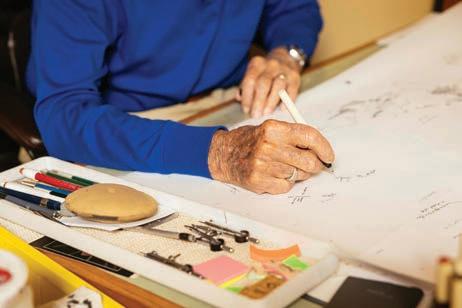
Mapping Battalion—the Army’s oldest mapmaking unit. While he had made Hawai‘i maps and charts for classroom lectures and publications in the past, he didn’t know much about the fiftieth state. “I came in green on that atlas project, because I was really green on the state of Hawai‘i. And, to make it even more challenging,” he says, “we were in a hurry. When I arrived, I set to work right away.”
Warwick suggested that the Biers stay at the Pagoda Hotel, a kama‘āina favorite off the beaten Waikīkī path. The hotel’s Japanese-inspired architecture and koi-filled water gardens reminded Bier of his stint in the Army during the 1950s, when he’d fallen in love with Japanese culture. After immersing himself with his assignment, the Biers started to explore and fell in love with Hawai‘i, too, as so many do.
“At that time, Ke‘eaumoku Street was just bustling,” Bier says. And they became devotees of Hawaiian music; to this day, half of Bier’s recorded music collection is Hawaiian, with the Sons of
Hawai‘i and Sunday Manoa featuring prominently. “It was the beginning of the Hawaiian Renaissance and an increased awareness of Hawaiian culture. I just loved the music,” Bier says. He followed the Sons of Hawai‘i around O‘ahu and saw them perform on neighbor islands. On their many subsequent trips to Hawai‘i, if the Sons of Hawai‘i were playing, there was a good chance the Biers would be there.
Cartography has been described as both an art and a scientific discipline. A cartographer interprets data that exist in a threedimensional world and records it accurately on what is (usually) a flat surface. Bier gathered information from government entities on the federal, state and local levels. These include the US Geological Survey, the National Park Service, the US Soil Conservation Service, the US Census Bureau, the Bureau of Sport Fisheries and Wildlife and the US Public Health Service. The work also includes information generated by Hawai‘i’s state Departments of Agriculture, Planning and Development, Land and Natural Resources, and Health in addition to information from county governments. Bier also relied on information from private entities like Bishop Museum, the Hawaiian Electric Company and the Pineapple Growers Association of Hawaii.
Adding to the challenge, Armstrong wanted the atlas to emphasize Hawaiian place-names, even in cases where the English name is more commonly used. For example, the atlas privileges “Mokoli‘i” over “Chinaman’s Hat” for the islet in Kāne‘ohe bay (Bier’s map of O‘ahu lists Chinaman’s Hat as a secondary name). “That’s the one thing I tried to do whenever possible,” Bier says, “to put the Hawaiian name first, and if there is an English name, to use parentheses after it, even if it might be the more commonly one used.”
This was easier in theory than in practice for a couple of reasons. First, the necessity of using diacritical marks in Hawaiian place-names. In the early nineteenth century, American missionaries created a twelve-letter Hawaiian alphabet consisting of five vowels and seven consonants. While this was functional, it was limited. Later, two marks were added, the ‘okina to represent glottal stops and the kahakō to differentiate short from long vowels. “During my research of place-names, I found one word that had six different meanings. Depending on where the diacritics are, the meaning would change. Pronunciation makes a lot more sense when you add those marks,” Bier says. While Bier incorporated them, he gives credit to Armstrong. “He was the one who came up with the idea of using the diacritics throughout the atlas,” Bier says. “Later, I would continue to use them on the series of maps of the individual islands I created for the University of Hawai‘i Press.”
Another complication in using Hawaiian place-names was in figuring out just what the Hawaiian names were. To advise Bier, UH Press tapped two prominent Hawaiian-language scholars, Mary Kawena Pukui and Samuel H. Elbert. The pair had worked together in 1957 on the still definitive Hawaiian Dictionary and later, in 1966, on Place Names of Hawai‘i. “I think the press brought them in to check on what I was finding, because they were the experts,” Bier says. “I would not even try to do it myself.”
Bier was impressed by Pukui’s expertise. “I would ask her Hawaiianlanguage questions and wonder how she could answer all of them,” he says. “Of course, she understood the language so well, it wasn’t a problem for her to
42

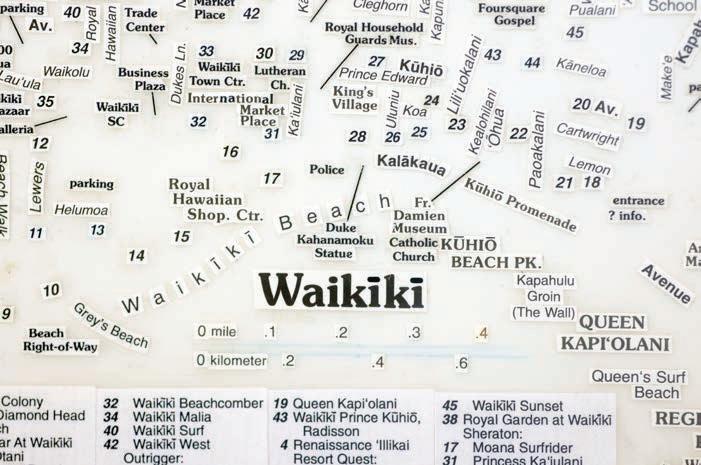
James Bier (seen on page 40) created hand-drawn maps of Hawai‘i that set a standard for all future cartography of the Islands. The Atlas of Hawai‘i, published in 1973, was the first resource to use Hawaiian place-names and included diacritical marks (seen above). Noted Hawaiianlanguage scholars Mary Kawena Pukui and Samuel Elbert assisted Bier in this effort at a time when Hawaiian language and culture was beginning to experience a revival.
scan through and say, ‘This is not right’ or ‘That is not right,’ and she would be done right away. It didn’t take her a lot of time to make corrections. Elbert was the same way but less visible.” At 76 Pukui seemed much younger to Bier than the 64-year-old Elbert. To this day Bier is amazed by her indefatigable nature. “She was a vibrant person, busy with so many aspects of Hawaiian culture. She even recorded a record album for children, which I have,” he says. “But she was also very quiet. Working with her was mentally calming to me.”
Bier stayed in Hawai‘i for a year, leaving in August 1972 once work on the atlas was complete. Now 94 and living in Illinois, he still recalls the project fondly. “It was just a delightful time period. Everything I did for the atlas was accepted. The press just loved it,” he says. “They understood my design ideas, the layout of the book and even why I
wanted an unconventional size, which emphasized the images.” One of Bier’s subtle touches was the use of rounded corners for the maps, which he hopes sends a message: “The rounded corners were meant to convey that the reader is looking at images of an island instead of a feature on a continent. Round makes islands feel like islands.”
After the atlas was published, students at UH Mānoa’s Hawaiian studies program took note of its sensitivity to the Hawaiian language. “We were at the beginnings of the Hawaiian Renaissance and the revival of ‘ōlelo Hawai‘i,” or the Hawaiian language, says Danny “Kaniela” Kahikina Akaka who was a student in the program at the time. “Language is the key to the culture. We were doing Hawaiian-language radio programs, Ka Leo Hawai‘i, as well as oral research and documentation with kūpuna [elders] on Hawai‘i Island. As the Hawaiian
language was going through a time of revitalization, Hawaiian place-names were an important consideration. Placenames had been substituted with English names, and some place-names had even been shortened out of convenience, thus losing the mo‘olelo [stories] behind the name as well as the mana [spiritual power] associated with the name. The maps had the correct place-names and also included the diacritical markers. They were valuable in the preservation of the Hawaiian place-names and in the context of the renaissance of Hawaiian culture,” says Akaka, who today serves as the Kahu Hānai, the Hawaiian cultural adviser at Mauna Lani Auberge on Hawai‘i Island.
As Bier was winding down work on the atlas, UH Press asked if they could republish some of the maps individually. A flattered Bier responded by saying they were too small for such a purpose. “When they suggested taking the maps
44


46

V
Now 94, Bier lives in Illinois, in a Japanese-inspired home he built. While Bier has created thousands of maps over his career, he calls his work on The Atlas of Hawai‘i “one of the best things I ever did.”

out of the atlas and publishing them individually for schools and other educational purposes, I had to say no— even if they had been blown up, they just didn’t have enough information. But I said I could do something better: I could make bigger maps, with more information. And that opened up something I had not thought about before. The truth is, that turned into the best move of my professional career. The new versions were more detailed than the originals. And I was given free rein on their design.”
Bier’s maps quickly became the gold standard and are still sold throughout Hawai‘i. They have remained continuously in print, selling more than 2.6 million copies so far at bookstores, gas stations, supermarkets and car rental agencies. The early versions were created with the assistance of Elbert and Pukui; later, UH Press brought in other Hawaiian-language experts such
as professor emeritus of Hawaiian language Puakea Nogelmeier. “Bier’s maps are a dense layering of data, and he prioritized Hawaiian knowledge in a way that had not been done for a long time and not on that scale,” Nogelmeier says, adding that the revised editions have continued to make the maps relevant. “New information continues to come to light as Hawaiian-language resources are rediscovered. I am hopeful that future mapmakers will follow Bier’s lead.”
Bier says that he and his wife have made more than forty trips to Hawai‘i to update the maps, driving every road on Hawai‘i, Maui, Moloka‘i, Lāna‘i, O‘ahu and Kaua‘i that he has drawn. While he stresses that fieldwork is important in mapmaking, he did skip one island: He was once invited to Ni‘ihau, but at the time he didn’t think he could improve on the existing maps. “I wish I hadn’t turned down
the opportunity,” he says wistfully. “I already had all the information I needed from the USGS, and from what I was told, there wasn’t a whole lot of detail to add by going there, other than physical features. It would have been nice to say I had been on the island.”
Over the years, sun and humidity took their toll on the archived materials Bier used to create the first and second editions of the Atlas of Hawai‘i, published in 1973 and 1983. The third and current edition, published in 1998, started almost from scratch, taking advantage of new digital techniques and remote-sensing technologies like infrared satellite imagery; it did not rely on Bier’s handdrawn maps based on survey data. Still, “The original place-names by Bier were important for all the mapwork in the state that followed,” says Tom Paradise, chief cartographer for the third edition, which preserved and updated Hawaiian place-names. “The old adage is that all
48
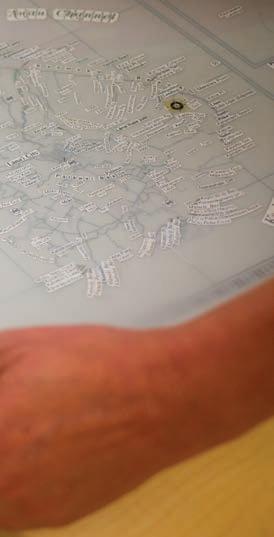
cartographers stand on the shoulders of the early mapmakers. This was true of us writing and mapping for the third edition, and it would have been true for Bier when he wrote and mapped for the first and second editions. The postwar maps of Hawai‘i were superlative and often act as references today.”
Throughout his more than sixty-year career, Bier estimates he has created more than three thousand maps, including other Pacific islands in Sāmoa and Oceania in general. But his work in Hawai‘i holds a special place for him.
“I am proud of what I have done,” he reflects. “As a cartographer working within a university or as an independent, it would be extremely difficult to publish my own stuff. For someone in my position to get a map published for sale— that would have been almost impossible. And yet, UH Press asked me. I had a lot of fun with this project. It remains one of the best things I ever did.” hh

A Tale of Two Ponds
A community unites the ancient fishponds of Loko Ea and ‘Uko‘a
STORY BY CATHARINE LO GRIFFIN
Mornings are quiet at Loko Ea. The pond is still, reflecting like a mirror the grass-covered banks and regal palms reaching for the clouds. The rising sun is still low, the air cool and weightless. A mile away, connected by a waterway hidden by decades of overgrowth, is ‘Uko‘a. This pair of loko pu‘uone, or nearshore sand dune ponds, form a unique, spring-fed fishpond complex— Na Loko I‘a o Waialua—that empties into Waialua bay. In ancient times these ponds were a bountiful food source

favored by the ali‘i (royalty), and they supported some eight thousand people. In 1813 a visitor named John Whitman documented his walk on ‘Uko‘a’s stone walls: “Here we observed thousands of fish, some of which were apparently three feet long.”
It makes sense that the ahupua‘a (land division from mountain to sea) that is home to Loko Ea and ‘Uko‘a is called Kawailoa, “the long water.” Hawaiian historian Samuel Kamakau described this freshwater system as “the long house” inhabited by the mythical mo‘o
(lizard deity) Laniwahine, who would swim to the ocean through a lava tube. According to lore, she was a fearsome guardian whose presence, caretakers say, is still felt today.
When Loko Ea staff arrive in the morning, they stand together and offer an oli (chant) in appreciation for this wahi pana (sacred place). Sometimes in the middle of the oli, says operations and education director Sayo Costantino, a breeze suddenly blows through, an invisible gust shattering the stillness. “It’s this magical response,” she says.
50
PHOTOS BY GREG HATTON
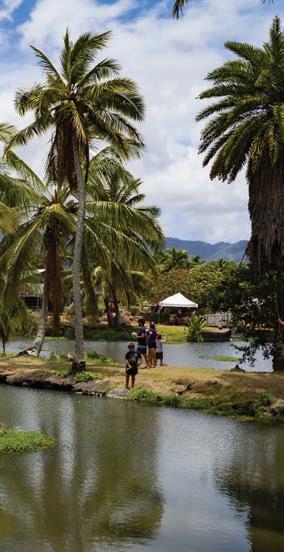
“You can tell someone’s listening.”
Although Loko Ea is visible from the road as you drive past Māeaea (more commonly known as Hale‘iwa Beach Park), many North Shore residents are unaware of its significance. Not half a mile away, Hale‘iwa town is noisy with bustle. Extreme bass thumps from lifted trucks stuck in traffic. Visitors chatter while waiting in line for shave ice.
Fishing boats and shark tours zip in and out of the harbor. At Loko Ea, though, the hubbub is neither seen nor heard.
“Once I walk through those gates,


I breathe a sigh of relief,” says Savili Bartley, a Native Hawaiian who serves as the fishpond’s nursery technician, a.k.a. “the plant guy.” He came to Loko Ea in 2020 following ten months of conservation work in Southeast Asia. Here, he says, he feels a sense of security and cultural connection. “No matter what happens at the pond, I don’t think I could ever have a bad day. It’s a mana [spiritual energy]-full state.”
“Once upon a time, before the idea of fishponds, it all started here with observation,” says Mālama Loko Ea Foundation (MLEF) co-founder James Estores, peering over a small concrete bridge into the shallow stream connecting the fishpond to the sea. “When the tide comes in, salt water comes in. When the tide goes out, the fresh water comes up.” This ebb and flow, he explains, creates the muliwai, the nutrient-rich brackish water at the stream mouth. “Look at the fish,” Estores says, pointing to dozens of baby mullet making their way from the ocean
toward the stream as fresh water flushes out of the pond. “These pua ‘ama‘ama are herbivores. The green color you see? That’s plankton, that’s algae—that’s growth. They want this.” The fingerlings swim against the flow to find food, slipping through the grated mākāhā (sluice gates) and into the pond, where they mature. Conversely, when the tide comes in, the bigger fish are drawn toward the sea. “I have stood at each of these [gates] while water is forcing its way in, and the fish are knocking into my legs. They want to greet this new water coming in,” Estores says. “When you drop the sluice behind them, they’re trapped. Now you can selectively harvest and take just what you need. Our kūpuna [ancestors] figured this out through the simple act of allowing the tide to occur. What is Loko Ea? It’s an amazing testament to the oceanographer, the zoologist, the engineer and the sustainable way they created this place six centuries ago. Today, in 2022, we can continue what they started.”
In April 2008 Kamehameha
Schools, which owns twenty-six thousand acres on the North Shore, approved its community master plan, which included the restoration of Loko Ea. That May, Estores volunteered. Inspired, he convinced his friend, Hawaiian Steam owner Benson Lee, to join him for a community workday in June. Equally enthused, Lee returned in July with his employees, an excavator and dumpsters. “Can’t get it done by hand,” Lee reckoned.
In early 2009 Estores and Lee were having lunch after building a pāpōhaku (stone wall) at the entrance of Loko Ea, when Hale‘iwa kupuna (elder) David Anana bestowed upon them a heavy kuleana (responsibility). “You see that?” he said, pointing toward ‘Uko‘a. “You need to open that up. That’s why you’re here. It’s going to be a lot of hard work. You’re going to learn a lot being in this place,” Estores remembers him saying. But the most important part of his message came next: “All those things you’re going to learn along the way? You share it. It’s not yours. It doesn’t belong
52
After decades of neglect, the pair of ancient fishponds named Loko Ea and ‘Uko‘a in Hale‘iwa, O‘ahu, have been cleared and restored; today they are again providing food. The effort has revitalized the ponds as well as the North Shore community’s cultural cohesion.


to you.” Uncle David emphasized the point by rapping his cane on the ground: “You. Share. It.”
Later that year Estores and Lee established Mālama Loko Ea Foundation, and in the thirteen years since, Loko Ea has been transformed. Removing vegetation was a colossal effort. There was a three-foot layer of fallen coconuts, a “jungle mess,” Estores
says, of invasive weeds and six-foothigh stands of California grass that had formed thick, floating mats. “We were on water and we had no idea. We were just going through with weed eaters,” Estores says. “All of a sudden we hit something. Clank, clank. We kept hitting it. There was a catamaran in there!”
Not only a catamaran, but a telephone pole, car axles and more
than thirty tires have been hauled out of the pond. The staff recently finished clearing the vegetation, and the pond has doubled in surface area. The banks are once again defined. Loko Ea is inhabited by ‘ama‘ama (striped mullet), āholehole (young Hawaiian flagtail), awa (milkfish), moi (threadfish) and pāpio (young jacks) as well as invasive tilapia and tō‘au (blacktail snapper). On land the
54
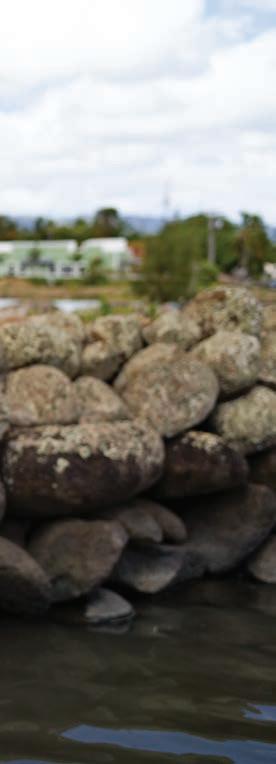
māla (gardens) produce kalo (taro), ‘uala (sweet potato), vegetables and herbs. ‘Ulu (breadfruit), niu (coconut), mai‘a (banana) and papaya trees offer an array of fruit for the picking.
“I always envision the plate of food from Loko Ea. The fish—the protein— is from the pond, and all of our māla help to fill out the plate. All the colors, all the food groups, right there,” says



Costantino. “Within the ‘āina [land] we have this ahupua‘a system in a really condensed form—everything that will help our community live and thrive. There’s nothing that connects us like food.”
Before the pandemic, between five thousand and six thousand students and volunteers passed through Loko Ea’s green gates each
year. Once gatherings were limited, the staff quickly adapted their education programs, shifting their attention to the North Shore community. “We really had been focused on conservation— habitat restoration and education from a cultural-traditional perspective,” says MLEF executive director Rae DeCoito. “But when COVID hit and we weren’t able to receive people, we had to think,
‘How are we going to respond?’”
COVID magnified the need for food sustainability, and Loko Ea provided a solution. Each month, with a handful of volunteers, the staff built an imu (underground oven) and delivered four hundred nourishing hot meals—kālua pig and kalo, turkeys for Thanksgiving—to local families in partnership with the North Shore Food Bank. “The imu effort
56

really made us understand that our kuleana was to nurture the families and the youth, specifically in our community, engage them year after year and grow them into this place,” DeCoito says. The staff, flexible and innovative, went on to design programs for small groups of keiki, teaching them how to kilo (observe), how to fish responsibly and how to propagate and plant native seedlings.


During one visit a group of kindergartners helped plant ‘ae‘ae, a coastal ground cover that provides habitat for nesting birds. On a subsequent visit the kids were delighted to spot a clutch of endangered ‘alae ‘ula (moorhen) chicks, easily identifiable by their bright red-and-yellow beaks, swimming around after their parents. Over six weeks last summer Loko Ea hosted groups of third through eighth graders in an immersive, five-day program, Nā Pili Wai Puke, which they expanded for summer 2022. On day one they learned how fishponds function and made their own bamboo poles. On day two they husked niu (coconut) and scraped the meat, which they used to make haupia (coconut pudding). On day three they visited the nearby lo‘i (taro patch), Nā Mea Kūpono, where they harvested, cleaned and prepared kalo. On day four they dug an imu in which they placed the food to be cooked overnight.
Their families were all invited for the final day, when the students became
the teachers. The kids could distinguish pua ‘ama‘ama from āholehole. Their sharp eyes caught sight of an ‘auku‘u (black-crowned night heron) perched on the bank. They demonstrated how the underside of ‘ulu leaves is sticky like Velcro. They held silvery-green leaves of pōhinahina to their parents’ noses, extolling the spicy scent. Most proudly, they opened up the imu and shared the feast they had prepared. “I get filled with emotion when I see their faces as they devour the fish they caught,” says aquaculture technician (a.k.a. “the fish guy”) Andrew Tabaque. “Loko Ea refers to ‘breath’ or ‘life,’” he says, referring to one translation of “ea” as “life, air, breath.” “This place brings so much life to the people that come here.”
The staff aims to raise a generation of stewards who will realize the dream of reconnecting Loko Ea to ‘Uko‘a. Currently MLEF is working with Kamehameha Schools to finalize a thirty-year lease and obtain a fifteenyear conservation license so that restoration of the tributary can begin. In the meantime, their next major
project is to dredge Loko Ea this fall, removing the silt that’s built up over the past century after Waialua Sugar Company diverted the water from ‘Uko‘a to irrigate its cane fields. A deeper pond will create a healthier habitat for the fish. Once that’s completed, the walls will be rebuilt. On land, a two-story learning center is in the works, bolstered by a $100,000 donation for a site management plan from the Nakupuna Foundation, which also committed to covering half of the construction cost. In 2021, MLEF was also awarded $2.2 million in federal funding under the Native Hawaiian Education Program.
“So often we think of things that are old—Loko Ea is four to six hundred years old—as things of the past that we learn about because they are history,” Costantino says. “No. We learn the history because it helps us go forward into the future—to feed ourselves, our families and our communities. These keiki and their families are restoring and catching and cooking and eating. Loko Ea is not a relic. It is alive.” hh
The restoration began in 2009; initially clearing the ponds was a massive undertaking that required heavy machinery. Today they’re maintained in part through community workdays (seen above), where everyone from keiki to kūpuna (elders) pitches in.
58

Playing in the Sand Waikīkī’s beach volleyball scene attracts players from around the world to the birthplace of the sport
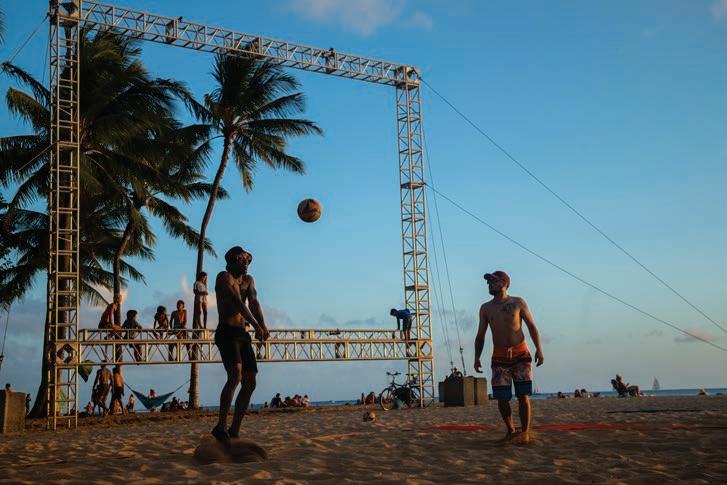
STORY BY LUKE WAIKS PHOTOS BY ELYSE BUTLER
60

Things start early at Waikīkī. At dawn the acre of flat sand next to Queen Kapi‘olani Pier is empty but for two men setting up a net. They attach chains to anchors deep in the sand and ratchet the net taught. Both are named John: John Stevenson from Santa Cruz is here on his wedding anniversary, sneaking out to play with his buddy from way back, John O’Connor, who lives nearby. As they warm up, they tell me about the huge beach volleyball scene in Santa Cruz: twenty courts and hundreds of people playing late into the night. Stevenson played AA and AAA volleyball back in the ’80s, while O’Connor stayed a consistent, albeit amateur, player.
Another pair arrives, eyeing the court. Rylee Dorer and Rahel Rüegg are both university students who play recreationally and want to get in an early morning practice. As a duo they consistently win matches against the average players, so the goal of this session is to improve their teamwork to prepare for the inevitable match against heavier hitters.
Eva Tcholakova, a freelance volleyball coach, sets up her own net nearby. She runs camps and custom coaching sessions in Waikīkī, but today she’s here just to practice. She regards the two Johns approvingly. “Those guys, you can tell they’ve been playing forever,” she says. Then she watches Rylee and Rahel. “The ladies could use some tips,” she announces bluntly, in her austere Bulgarian accent. Rahel and Rylee agree to run a quick drill with Eva, who bats balls at the pair while dispensing instruction and encouragement. Eva
trains a Bulgarian women’s team for a few months a year in Europe, as well as high schools and colleges here in Hawai‘i that don’t have year-round programs. After Eva’s quick defensive drill, Raylee and Rahel are sandy and sweaty, appreciative of the coaching. John and John look ready to play, so Eva backs off and the game commences.
It’s a pretty even match. The Johns seem to know telepathically where to position themselves based on the position and body language of their opponents, tracking the ever-changing trajectory of the ball. They casually swat the ball to each other, then over the net in the exact places their opponents aren’t. Raylee and Rahel have to work for their saves and points, shouting clipped instructions and tips to one another. John and John are nearly silent, at ease like the old friends they are.
A local volleyball school called Spike and Serve arrives, sets up its own nets, and by 10 a.m. a dozen school-age coeds are going through their drills. More nets go up, more people filter in and by noon it’s close to a mob scene, with players lined up on the sidelines despite the heat. It might not come as a surprise that beach volleyball is popular in a place where the beach is the most popular place to be, but what those unfamiliar with the sport might not know is that Hawai‘i isn’t just a beach volleyball mecca: It’s the birthplace of the sport.
Historians have pegged the first game of beach volleyball to 1915 at the Outrigger Canoe Club, about a mile from Queens Beach. Indoor volleyball had existed since


ABOVE / The
OPENING SPREAD / The
FOLLOWING PAGE / Competition at Queens can be fierce but friendly, and it goes well past dark. Two competitors give each other five as they switch sides on the court.
Outrigger Canoe Club’s beach volleyball players (seen also huddling on the facing page) practice with coach Lia Young Hunt (in black).
scene at Queens Beach in Waikīkī; Omari Brown bumps to his teammate (left); Kelsey Morrison sets up for a spike (right).
62



1895, but it was the Waikīkī beach boy George “Dad” Center who first strung a net between two palm trees so he and his friends had something to do while waiting for good surf. One of his friends whom he coached in swimming and paddling, the legendary Duke Kahanamoku, was mistakenly credited with inventing the sport just because he happened to be in the neighborhood at the time. With Duke busy evangelizing for the other sport that originated in Hawai‘i—surfing—and winning Olympic gold in swimming, it’s no mystery that beach volleyball took a back, back seat among Island-inspired sports.
Beach volleyball started coming into its own during the Depression, when work crews leveled an area of Santa Monica Beach and set up nets to provide cheap recreation. While the sport spread on the Mainland—in California, predictably—it also grew locally. About a mile down the Waikīkī shore from Queens is Fort DeRussy, site of a famous hotel and leisure spot for military service members. The official sand court sits empty, a casualty of the recent pool renovations. No matter, because local players took it upon themselves to sink enough net anchors for four courts in the nearby, if imperfect, beachside.
Farther along, near Kewalo Basin at the ‘Ewa (western) end of Waikīkī, there’s a patch of sand big enough for two courts. There’s less of a social scene here—it’s mostly joggers on the Ala Moana loop—but the early birds are here at dawn to play before it gets hot. I watch a short, fit fellow play every match before 10 a.m., and his buddy alternates playing with him, against him and coaching him from a folding chair. The coach is Lokene Campos, a Kamehameha Schools grad and, until he moved back to Honolulu recently, volleyball coach for South Carolina high schools and colleges. His very active friend is 21-year-old Caden Albert, who’s visiting from Charleston on a “vacation” that’s more like a marathon training session. Lokene had coached Caden in college, which lit the fire that
led to Caden founding the College of Charleston’s first indoor volleyball club (there isn’t a recognized NCAA men’s beach volleyball program; it’s women only) while dreaming of life on the road as a pro. Caden’s road to pro has him sleeping on Lokene’s couch and playing volleyball ten hours a day for all ten of the days he’s here—a crash course in Hawai‘i beach volleyball.
The scene wasn’t always like this. Despite Hawai‘i being the birthplace of the sport, the pro circuit started in Southern California and then spread to Rio de Janeiro, Brazil, then Marseille, France, and beyond. While indoor volleyball became comparatively huge, the beach variant puttered along in the shadows of sports until seeing big bumps in the ’80s, ’90s and again recently. In 1996 beach volleyball was included in the Olympics, and by 2011 the NCAA recognized women’s beach volleyball as an emerging sport, encouraging colleges to field the first women’s teams. The first NCAA national championship was held in 2016. Now there are eight conferences and 160,000 scholarship slots per year. As you might guess, the sunshine states have the strongest presence in the championship brackets, with the University of Southern California taking the honors in the final against Florida State University in the 2022 NCAA national championship. The University of Hawai‘i has a top-notch women’s beach volleyball team along with top-ranked men’s and women’s indoor volleyball teams. The peak of the swell was the Association of Volleyball Professionals NEXT event at Queens Beach in the late ’90s, but we have to go to the roots first.
Beach volleyball is a lot like most other sports in the Islands: as much a social scene as a competitive one. Matches go all day and into the evening, with at least one net up and a handful of pickup players. The pau hana (after work) crowd starts arriving at 4 p.m., Thursday and Friday especially, and they come with kids, coolers,


66
TOP / The “King of Queens” Fernando “Mosi” Mosqueda dispenses friendly coaching to all who visit his courts.
ABOVE / Peter Lyudmer and Yuri Asipouvieh face off at Queens on a Friday afternoon.
RIGHT / Lyudmer leaps for a return.

stereos, awnings and dogs. You’ll see guys in jeans and polo shirts fresh from their day jobs, but most are in swimwear so they can jump in the ocean to rinse off the sweat and sand. How does a newcomer break into this scene? Easy: You talk to Mosi.
Fernando “Mosi” Mosqueda is the jovial guy with a shaved head and a shard of a white beard who sits in a beach chair closest to the walk. He’s there “almost always, sunup till after sundown,” he says, adding, “If I’m on the beach, I’m in my happy place.” And happy he seems, offering a running commentary of all the matches simultaneously, plus coaching tips disguised as heckling, all while greeting newcomers and assessing their skills. Some call him the King of the Court at Queens Beach, but he’s equal part court jester.
Nicholas Ryu is an indoor volleyball player visiting from San Francisco. Mosi makes quick work of him. “Nick-fromSan-Fran, go pepper with Luke-thewriter. Show me what you know.” Nick and I borrow a ball that we “pepper,” batting it back and forth in a friendly, getto-know-you warmup off-court. I hardly know what I’m doing. Nick is always able to lob the ball directly back to me, but he stumbles chasing my wild returns.
Mosi watches while eating a snack from a nearby birthday potluck. First, he tells me the embarrassingly obvious: When passing to your teammate, lob the ball high to give your partner time to get under it. This helps your team stabilize the ball and set it up for a return, which must be done in three taps at most. Mosi sets his food down to demonstrate the basic stance: feet wide, knees bent nearly sumo-style, hands joined with thumbs together and in line with my forearms. The forearms are the primary volleyball launchpad for know-nothing beginners like me. When I’m able to get my forearms directly beneath the ball, I can return the ball to Nick on a similar arc. Mostly. The thick, ankle-deep sand confounds us both.
“Moving on the sand is much slower than on a hardwood floor,” Nick says.
“That’s the hardest thing. It feels like a different sport.” It pretty much is. Indoor volleyball has a different set of rules and team dynamics. “Indoors, there’s six of you on each side, less space for you to cover on your own, huh?” Mosi says. “So just two of us covering the whole court in this sand,” Nick pants. We are both huffing and puffing after just fifteen minutes of peppering. “High-step those knees, take salsa classes if you need to,” says Mosi, who knows how to transition from indoor to beach and back again. When he isn’t holding court at Queens, he’s a professional referee and occasional commentator for international volleyball competitions, both indoor and beach. He just returned from refereeing the Amateur Athletic Union junior nationals in Orlando, followed by a National Senior Games Association competition in Ft. Lauderdale. Reffing has taken him nearly everywhere.
Mosi finds a suitable teammate for Nick-from-San-Fran and watches the match. For me he recommends the fouron-four mob of drunk college students on the far court. I decline and chill while another handful of hopefuls arrive, and the cycle begins again. It goes on like this for hours, with Mosi talking story, talking smack and matchmaking for absolute newbies and visiting pros alike.
And the pros do visit. In the late ’90s, pro beach volleyball made its way back home. Paul McCurdy was a member of the Oahu Volleyball Association, which largely made that happen by inviting the AVP NEXT tournament circuit to Queens Beach (AVP, founded in 1983, is the only domestic professional beach volleyball league). “That was a bit of a hassle!” Paul says. “We had to fill out all these forms, and all have memberships.” But it ignited interest in the community. Paul rattles off the names of a dozen local folk who started in that era and went pro afterward. “We saw so many come through we could tell who could make it big,” Paul says. Like Sean Scott, a UH indoor volleyball player who joined AVP in the ’90s,

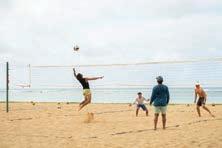
68
TOP / Eva Tcholakova from Bulgaria coaches two players at Queens.
ABOVE / Players at Ala Moana Beach Park
RIGHT / Lia Young Hunt coaches a young athlete at Outrigger Canoe Club.

earned rookie of the year in 1999 and rounded out the following decade on the AVP tour. Others carried the torch from that generation of pros: Kailuaborn Tri Bourne competes in AVP and Fédération Internationale de Volleyball tournaments, placing consistently high since playing for the Outrigger team and bringing home bronze in the 2007 Junior Olympics as well as being named AVP Rookie of the Year in 2013. He went on to compete in the Tokyo Olympics in 2020.
After the AVP NEXT competition, the scene evolved to what it is now: a place for anyone to share the sand with a pro or even an Olympic-level player, a pure expression of aloha in sport and spirit. Jan Resuello caught that wave of interest in the ’80s and has been a regular ever since. “When I started beach, I loved coed, then just started somehow playing with the gals. I got lucky and played with some legends like Lia Hunt and Karrie Trieschman, and guys like Eyal Zimet and Jason Salmeri,” she says. “I just wish I was more serious back then!” Nowadays she’s sharing her love of the sport by coaching the ‘Iolani School and Ku‘ikahi Volleyball Club’s indoor teams.
If you’re truly serious about making the circuit or pursuing a college scholarship, you should probably start in your early teens at Outrigger Canoe Club. Volleyball is so much a part of the club that they built three sand courts on the second floor. Lia Young Hunt prowls these courts while her assistant coaches run drills for a dozen teenage girls. “There are four drills these girls have to master before they get to me,” Lia tells me while simultaneously watching all three courts, noting each girl’s progress. Students begin the program at age 14 under the supervision of four assistant coaches, then Lia personally trains them for competition.
Lia uses a system she calls stack training, which starts with the fundamentals of good technique, then adds layers of drills and scenarios all
culminating in a more freeform drill toward the end of practice that brings it all together. It’s not just the practice sessions that run up to three days a week; this stack concept is replicated over the long season from October to July. The culmination comes during finals in July, when the entire season’s worth of training and conditioning is put to the test at the Beach Volleyball Clubs of America national championship in Hermosa Beach, CA.
Phoenix Clarke has been through the gauntlet of Lia’s coaching; this summer she’s headed to Stanford, where she’ll play volleyball. Dad Jamey and mom Nancy watch from the bleachers, enjoying one of the last practice sessions at Outrigger before Phoenix heads off to the world. Her sister Indigo, a sophomore at Punahou, is sharing the sand and sweat with her big sis. In the off-season Phoenix and Indigo paddled to two championships on the Punahou canoe team. “Volleyball started as just a family-fun thing,” Jamey says. “Phoenix was a swimmer and water polo goalie until she was about 13.” Nancy adds, “Lia pointed her out to Andrew Fuller, the head coach at Stanford.” Lia remembers, “During a timeout in one match, I said, ‘You know you are a water polo player who happens to be playing volleyball, right?’ Phoenix laughed, settled herself and just crushed the rest of the events.”
Lia can spot talent. She was an AVP athlete on the competitive circuit with sponsorships from Nike and Bolle, all while becoming an aircraft mechanic and pilot. She would later take over her father’s aviation business, Goldwings Supply, which she has grown to service major government and military service contracts. She’s focused and articulate. I get the feeling I’m sharing space with a rare, elite coach.
“Life experience is a huge factor in developing athletes. It’s critical to develop IQ as well as EQ in my athletes,” she says, referring to Emotional Quotient, similar to
Intelligence Quotient but for the world of interpersonal relationships. Lia says a truly prepared athlete can fit into any team almost instantly and adjust to any opponent. Once out on the AVP tour, she tells me, you might be partnered with a complete stranger at a moment’s notice. During the Tokyo Olympics, Hawai‘i’s own Tri Bourne was suddenly subbed in for Taylor Crabb, a fellow Outrigger alum who took ill. They won the match, then were defeated in a later round but only by the world’s best. Lia says being an athlete means identifying personal strengths and vulnerabilities while cultivating athleticism and skill— as well as being able to size up your opponents. “After the first seven points of a match, you should know enough about the other team and adjust that to yourself and your teammates.”
Lia has coached dozens of girls to NCAA scholarships, but not by coaching them into being world-class volleyball players. “Athlete first,” she says. “Be an athlete who happens to play volleyball.”
It’s late in the day, and the serious athletes have donned socks to protect their feet from the roasting sand. This isn’t the d rinking league. On three of the four courts, the matches are heated and close between old pros and some emerging amateurs. The party crowd is watching or wandering down to Fort DeRussy. Caden chugs water, sneaking snacks and playing like a man dead on his feet. Mosi keeps up a steady, hilarious commentary. I’m fading as a spectator but this scene isn’t slowing down; it will persist long after dark. The same seems true for beach volleyball all over the world—the Paralympic Games have sitting volleyball, the US Veterans Administration has started leagues for three-on-three adaptive beach volleyball for amputees, and there’s even a snow volleyball league for obviously crazy people. But wherever else beach volleyball sinks its anchors in the sand, it will always be at home in Hawai‘i. hh
70

Eyes of the Kānaka Portraits of Moloka‘i’s People

72
PHOTOS BY PF BENTLEY

Kāla‘e Tangonan
My family goes back five generations on Moloka‘i and my mother’s family three. Her family is from the Big Island, eight generations. Her great-great grandpa was a rancher, a paniolo [cowboy]. Then my greatgrandma moved to Moloka‘i. We’re really in the community, my family. My uncle is Walter Ritte, a Hawaiian activist. My other uncle is a mortician because my grandpa was the only mortician on the island. My uncle and my dad delivered me at home. I’m one of nine children. I’m a local artist here. There aren’t too many Hawaiian artists. We’re also generational lei makers. On Moloka‘i, you get lost in the feeling of connectedness, and being home and finding a place where you really, really belong.
Kawika Foster
There’s a presence moving through me in the photo. It’s the spirit of my ancestors talking through me. Not only did our ancestors survive, but they ensured that their essence and their spirit were not lost. Being on Moloka‘i, in connection with lineage, contributed to the essence that comes through in this photo. Moloka‘i is old-school. It has that presence. Our kūpuna [ancestors] need to see it in us so that their spirits can be at peace. They need to see the new generation channeling that energy, so that they can be assured that their effort to pass it on has been fulfilled. It’s what we do. We share.
Ikaika Bishaw-Juario
Throw netting is an ancient art. It was taught to me by my father. To me, it’s probably the hardest method to learn of all the fishing techniques. In the Native Hawaiian way we have a kapu system, where certain species can’t be gathered during certain times of the year because that’s when they’re spawning. And when you take, just take what you need and let the rest go. Growing up on Moloka‘i you’re taught the old ways, and you also take a little bit of the new world and you kind of forge your own life with both. I expect my children will do the same—carry on the traditions and also learn which direction the world is going.
74

Greg Solatorio
I grow traditional food, I farm, I practice the traditions of my ancestors. This photo shows how I live every day. We are the ones who share culture with the younger generation. We share it with our brothers and sisters and their children. We share it with family who may live farther places now, who no longer see these things every day. We’ve got to make sure they see these things, so they can carry on who they are and where they come from into the world. Showing how I carry the kalo [taro] over my shoulder represents carrying culture and tradition into the new generation and the next. It represents family, ‘ohana, and how we keep our traditions alive and moving forward. How we plant, how we harvest—generations carry on.
David “Maka” Makaiwa
I’m a farmer, a fisherman, a hunter. I live on forty acres of Hawaiian Homestead land, the fourth generation on this land. What was handed down to me from my father, I hand down to my kids. My kids always have a place to come back to if they no can make it any other place. What I want to pass down to my kids is to learn about surviving in this world, because it’s not going to get any easier. Respect the culture, respect the land. My faddah, when teach me and my uncles, teach me when we go in the ocean and get our food, we only take what we need. We no sell nothing. If someone need, we help them out. And the kūpuna [elders] are da numbah one, they teach us preservation. We just keep on trying. If we no succeed, just keep on trying.
Bobby Alcain
The basic understanding of the culture is to live aloha. Currently, I’m growing a sustainable life. I grow fruits, a garden and a lot of native plants because in time the native plants will be used to restore culture and life on the land. All the stories and chants are related to the native plants in a sense. If you look at native people as indigenous to the land, and you look at the plants as the DNA of the land, it makes sense that the plants need to be part of the culture. That’s the healing process: To heal the land you heal the people. If you live aloha, then you understand what it is you need. You need the native plants, you need each other, you need the ocean. Live aloha is the wholeness of life.

76
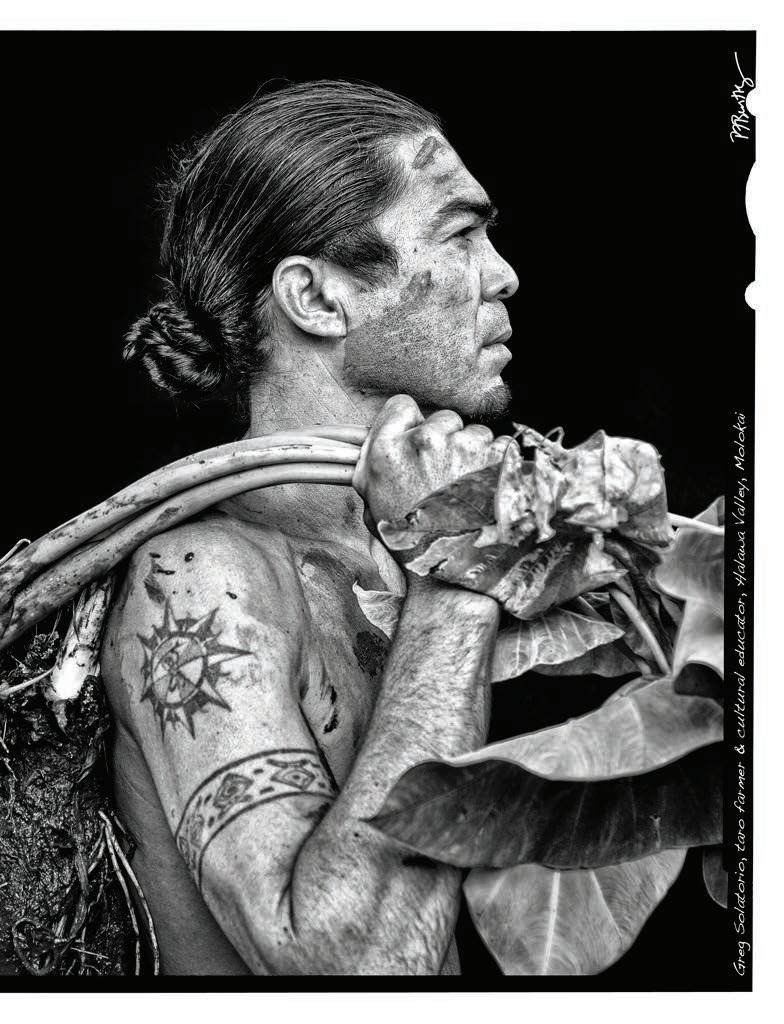

78



81

82

Samson K. Ka‘ahanui
I been here my whole life. I get eight kids and eight grandkids. We always clean up after ourselves. I always try to teach my kids. I been to Honolulu, dat place crazy. Here everybody knows everybody. My family goes back here kinda long, yeah? East end side my mom and dad born and raised. They used to grow taro before. Do a lot of fishing. We still do a lot of hunting, fishing. When they’d catch something they’d share wit’ everyone. The kupunas, the older generation, they be good fo’ talk to. I always look to the older generation for advice, fo’ talk story.
Anakala Pilipo Solatorio
Culture is sacred, not secret. You learn culture from the inside out, not the outside in. Nānā i ke kumu: Go to the source.
Uncle Jimmy Duvauchelle Sr.
I’ve been here all my life, seventy-eight years, and many people don’t know paniolo [cowboy] culture. But it’s a part of Hawai‘i’s unique culture. Sadly, we are a forgotten culture. I want to tell people who we are and where we come from. We are Hawaiian cowboys. We are Hawai‘i-made. We raise grass that feeds the animals, and it connects us to the land. But it’s more than that. It’s a lifestyle, it’s how we live. My children are paniolo, my grandchildren are paniolo. They carry on the tradition.
Kananikalā Bishaw-Juari
My family goes back on Moloka‘i four generations. I’ve always been here. My connection with music brings a language that everyone can understand and relate to. It brings people together. Moloka‘i is very special, and the culture is always there. It’s up to people who visit to be open to learning about our way of life and the way that we were taught to connect with people. As long as you come in with that respect, towards the land and the people, they will show aloha to you.
Aunty Snooky
My grandfather was an original homesteader here. I first came here in the ’60s, and when I stepped off the plane, it was like, ‘Oh my God. This is my home.’ Acknowledge your ancestors. On behalf of my ancestors and on behalf of God, I’m a divine instrument. It didn’t begin with us, ok? The chain that binds us. So we gotta get back into our ancestry. Talk with the tutus [grandparents], communicate with them wherever the ever began. Learn how to love you, every ounce of you, and learn forgiveness not only for yourself but for all. Wherever you go, ask permission and listen. I do a small oli [chant] and the birds will answer me, and they guide me from tree to tree. This is my home. I know who I am, honey, and all that I’ve been. I bore nine children, I have seven still living. Twenty-plus grandkids.
84
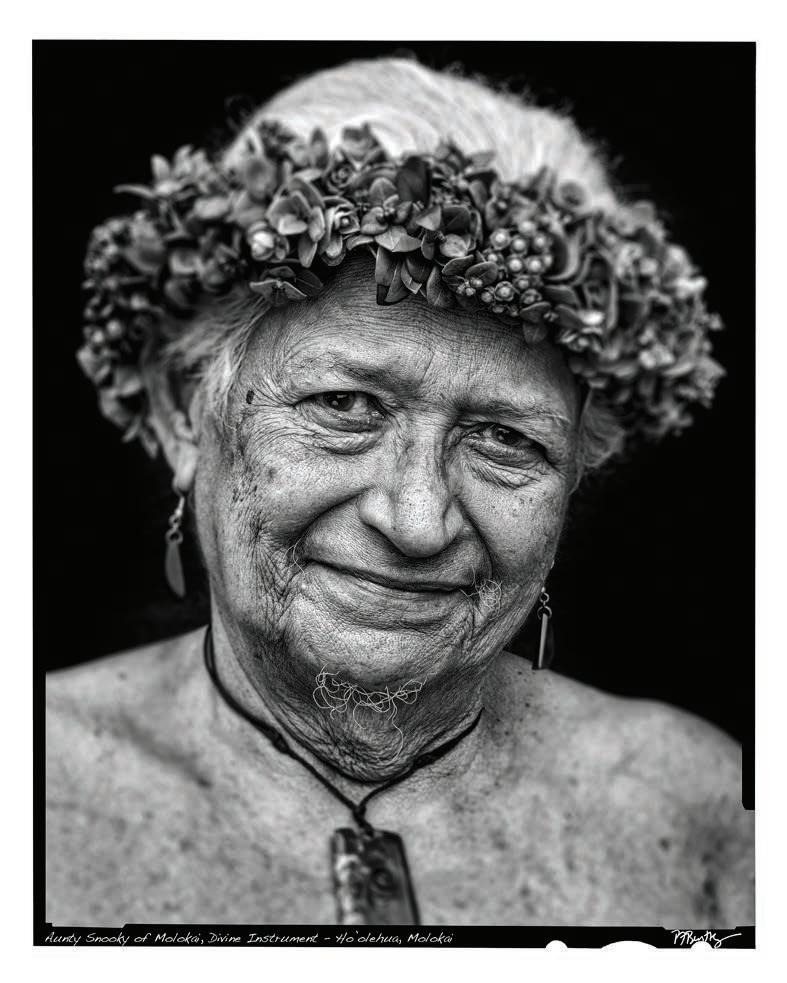
The Gods in Us
Kawai Strong Washburn’s debut novel captures the myths and realities of life in the Islands

PHOTOS BY MEGAN SPELMAN STORY BY ANDERSON TEPPER
86



“I wanted to center the story in such a sacred place, which was also part of my life growing up,” says writer Kawai Strong Washburn of Waipi‘o valley on Hawai‘i Island (seen on the opening spread, left), where some of his acclaimed debut novel, Sharks
the
is set. Above and on page 94, Washburn on Kona Pier, off of which the protagonist of the novel is saved from drowning by what might be ‘aumakua—deities—in the form of sharks.
Sharks in the Time of Saviors, Kawai Strong
Washburn’s acclaimed 2020 debut novel, begins with a vision set in Waipi‘o, on Hawai‘i Island. It’s pau hana Friday in the late ’80s, and young couple Malia and Augie have made their way to Waipi‘o’s black-sand beach to frolic in the back of their pickup truck. Suddenly, they spot a string of lights moving in the distance. Could it be the night marchers of Hawaiian legend, they wonder, the spirits of ancient chiefs and warriors?
“We’d heard of the night marchers but always assumed it was only a myth, part of a hymn of what had been lost to Hawai‘i, these ghosts of the long-dead ali‘i [chiefs],” Malia thinks. “But there they were. Marching slow on their way up the ridge headed for the black back of the valley and whatever waited there for undead kings in all the damp and darkness.”
The scene blends earthy realism
with elements of myth and magic, and introduces the themes of past and present Hawai‘i that reverberate throughout the book. For Washburn, 39, who was born and raised on the Hāmākua coast nearby, it was a natural place to open the story, rich in symbolism and personal meaning. “Waipi‘o valley is a place that is very important and sacred in Native Hawaiian culture, beliefs and history, so that was one of the reasons I wanted the novel to kick off there,” he tells me over Zoom from his home in frigid Minneapolis (“With wind chill, it’s like minus twenty today!”) when we speak in January. He is warm and demonstrative, especially animated when talking about his roots in the Islands and broader issues of environmental and social justice in both Hawai‘i and Minneapolis.
“I wanted to center the story in such a sacred place, which was also part of my life growing up,” he says. The novel is informed by Washburn’s own experiences in Honoka‘a in the 1980s and ’90s,
though it’s imbued with magical touches. Nainoa, who is conceived on that night in Waipi‘o, might possess special powers himself. When he is miraculously rescued by a shiver of sharks off Kona as a seven-year-old, his parents believe their suspicions are confirmed: Could Nainoa, in fact, be the savior his family, and the Islands, desperately need? (His siblings—Dean, nine, and Kaui, four, at the time—are less convinced of his superhuman gifts.)
Years later Malia will wrestle with the burdens she and Augie placed on Nainoa. “Sometimes I believe none of this would have happened if we’d stayed on the Big Island, where the gods are still alive,” she says, invoking the fire goddess Pele and the war god Kū, who also appears as a shark. “I wonder if some of him is you, and if some of you is him, the way the ocean and the dirt and the air here are all made of the gods. It was what I believed at first: That you were made of the gods, that you would
89
in
Time of Saviors

it was a very obvious, unspoken part of my experience of the Islands because I grew up in Honoka‘a, which is a blue-collar town.” The local sugar industry was thriving throughout his early childhood, Washburn recalls, but had shut down by the time he was in sixth grade. In the novel, when Augie loses his job in the mid-’90s, the family relocates to Kalihi, on O‘ahu, where a relative helps him find work. Later, all three of the children leave the Islands in search of greater economic and personal opportunities, scattering across the West Coast to Spokane, Portland and San Diego.
Another important aspect that Washburn wanted to capture was the unique ethnic and racial mix—the hapa culture—that he knew as a child on Hawai‘i Island. “In my experience growing up in the Islands, sometimes people could name all their racial and ethnic backgrounds, and sometimes they couldn’t or didn’t really care to,” says Washburn, whose parents are originally from Oklahoma and Missouri but met in Hawai‘i while his father was doing a PhD at the University of Hawai‘i at Hilo. “I had friends who were a variety of races, and I wanted to render that in the book. I think it’s one of the things that I appreciated about the Islands, and it was something that didn’t make me feel as much of an ‘other’ as when I came to the continental United States—which is part of what drove me to write the book.”
be a new legend, enough to change all the things that hurt in Hawai‘i.”
Washburn spent ten years working on Sharks in the Time of Saviors, never quite sure whether it would find an audience—or publisher—but determined to write the novel he himself wanted to read. The image of a young boy being guided to safety by sharks appeared to him one day, he says, and wouldn’t let go of his imagination. He carried it with him as he moved across
the country, from Washington, DC, to the Bay Area, before finally settling in Minneapolis. Who was this boy and where was he from? he kept asking. Eventually, he decided, the story would take place close to home and would be based on the realities of life in Hawai‘i.
“As I started to write and settle on who this family was, I knew that one of the things I wanted to talk about was the socioeconomic state of the Islands, which a lot of people are not really familiar with,” Washburn explains. “For me
After leaving Hawai‘i at 18, Washburn says, his identity became a source of frequent fascination and confusion. “As I began to write, I realized there were all these experiences, these unnamed moments, when I felt like an outsider because of my racial and ethnic background,” he explains. “People were always asking me, ‘Who are you?’ ‘What are you?’ Because nobody could quite figure it out. Why does it matter? It didn’t matter in the Islands. They could tell I wasn’t white, and that was all that really mattered.”
Washburn’s book ultimately found a publisher—one of the country’s most prestigious ones at that. Farrar, Straus and Giroux, based in New York, also happened to be the home of Lois-Ann Yamanaka, whose pidgin-rich books such as Saturday Night at the Pahala Theatre, Wild Meat and the Bully Burgers and Blu’s Hanging inspired
90
It’s rare for writing about Hawai‘i to make much of an impact on the literary world beyond the Islands, but Strong’s book won the 2021 PEN/Hemingway award for a debut novel.



“I get there and I can feel the difference,” says Washburn of visiting the Islands from his current home in Minneapolis. “The humidity of the air and the majesty of the natural environment—those three peaks on the Big Island that were backdrops for most of my youth—just trigger something in me. I could feel it feeding my soul.” Above, a view of one of those peaks, Hualālai, from Kona Pier.
Washburn. “Her characters are born and raised in the Islands, and the Island part of their identity and culture resonated very strongly with me,” says Washburn, who recalls the thrill of discovering Yamanaka and being “seen” in her books. “It was the first time I had read something by an author from the Islands, about the Islands, that was like, ‘If you’re from here, you’ll get this. If you’re not, you’ve got to come along for the ride. But I’m not writing to explain the Islands from a foreigner’s perspective. I’m writing about them in the way I experienced them and I lived in them.’”
It’s thanks to Yamanaka and other groundbreaking Island writers such as Kiana Davenport and Kaui Hart Hemmings, he says, that his own path to publication was much smoother in the end. He also points to an overall shift in publishing that has opened the way for authors from more diverse and underrepresented backgrounds—writers such as Marlon James, Tommy Orange and Ocean Vuong, for example, whose work
he feels he is somehow in conversation with. “It’s much more acceptable now to write the sort of book I’ve written and have it get published without a second thought. Whereas I’m sure for writers like Kiana and Lois-Ann, it was an uphill battle.”
But even with the backing of a major publishing house, Washburn’s novel faced serious challenges when it came out in March 2020. The pandemic had paralyzed the country, and book tours, like much else, were canceled. Things got worse in Minneapolis after the death of George Floyd in May. Washburn felt “wiped out” and shattered: “The city was on fire, and people would call me to talk about my book and I was like, ‘Who cares about my book! Does this book matter whatsoever right now?’”
And yet, eventually, attention did turn to his book, and accolades and awards followed. Washburn was humbled by the praise the book garnered from the very contemporaries he so admired: Marlon James called it a “ferocious debut”
told “with daredevil lyricism to burn”; Tommy Orange raved, “It’s so good it hurts and hurts to where it heals. It is revelatory and unputdownable.” Writing in the New York Times, Imbolo Mbue summed up her glowing review, “This passionate writer cries out for us to see Hawai‘i in its totality: as a place of proud ancestors and gods and spirits, but also of crumbling families and hopelessness and poverty. Of mystery and beauty at every corner.”
The book would go on to win the 2021 PEN/Hemingway award for debut novel and the 2021 Minnesota Book Award, among other prizes. And, perhaps most exciting, Barack Obama named it one of his favorite books of the year. But even that was hard for Washburn to appreciate under the circumstances. “These last couple of years have been awful for so many reasons,” he sighs, “that I don’t know if I’ll ever be able to enjoy those things—the awards, the interviews, the lists—as much as I could have without a pandemic, the murder of George Floyd
93
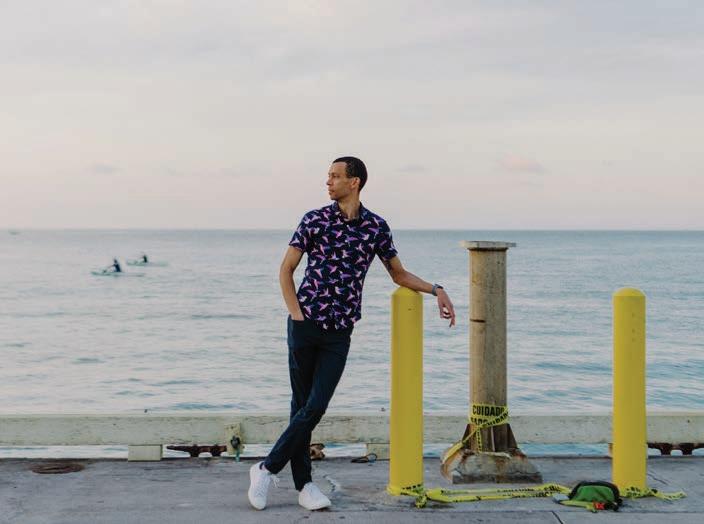
and the massive social unrest and racial reckoning that’s happening in the Twin Cities right now.”
This past December, Washburn returned to Hawai‘i for the holidays with his wife and two young children, his first trip back in four and a half years. The Omicron surge, sadly, put a wrench in most plans. He wasn’t able to do any belated readings or events, but he was able to drop by several Kona bookstores to sign copies and meet with booksellers. And just being home in the Islands had an ineffable effect. “I get there and I can feel the difference,” he says, his eyes lighting up. “You know, the humidity of the air and the majesty of the natural environment—those three volcanic peaks on the Big Island that were the backdrops for most of my youth—just trigger something in me. I could feel it feeding my soul.”
In Sharks in the Time of Saviors,
Nainoa, Dean and Kaui all end up coming back to Hawai‘i Island after failing to find what they were seeking elsewhere. But only Kaui—who works on a local farm while caring for her ailing father— is able to forge lasting ties there. “People have different readings of the book,” Washburn argues, “but for me the thing that I thought it ended up being about is a recognition that to be the best version of ourselves, we need to honor the truly interconnected nature of humans in the natural environment.”
Kaui, like her parents in Waipi‘o, will have her own stirring vision linking her to Hawai‘i’s past: “They are there. Finding me when I close my eyes. Women who can only be Kanaka Maoli [Native Hawaiian], skin joyfully dark and thick with work, proud cheeks and eyes full of the old island ways. … They dance on a hilltop. They dance in a valley. Kaholo, ‘ami kahela, lele, ‘uwehe. They reap in bundles with hands plunging into
dark-brown soil that gives and gives and gives. Something is alive all over my body now. Something like a hula that won’t stop dancing.”
Back in the polar airflow of Minneapolis, meanwhile, Washburn is at work on a new book that he calls “almost purely a climate justice novel.” He is interested in exploring how racial and climate issues will play out in the decades to come, and he is surprisingly optimistic. “I want to believe in a future where we undo the history of institutional racism that leads to the sort of environmental injustice we’ve seen,” he insists. “I want to write about that so I can help make it a reality. I believe in that world; I want to build it.” And even if it has been hard to move things forward politically, he admits, he still feels “incredibly powerful” as an artist. “I write stories, I imagine worlds, and why not do that in a way that pushes back at this prevailing narrative that the future is doomed, right?” hh
94


La Maui Vita Artist and bon vivant Piero Resta created a life and an Italian villa—in the wilds of Kaupō

STORY BY JACK TRUESDALE PHOTOS BY VIOLA GASKELL
96


Above, the gate to Villa Tamarinda, Piero Resta’s Mediterranean-style home in Kaupō, Maui. Resta (seen on the opening spread, left) was a bit of a Renaissance man; in addition to painting, he was an accomplished fashion photographer. At right, bottom, Resta’s shoot for Mademoiselle in NYC. At far right, “Ancient and Future Cities of Light.” On the opening spread right, “When Truth Rings a Bell.”
The southeast flank of Haleakalā slopes into the Pacific; the Maui sky vaults over the southern horizon. About an hour from the nearest town in either direction along Pi‘ilani Highway, a few clustered houses comprise the village of Kaupō. Here the humid jungles of Kīpahulu turn to dry grassland, and cattle roam the road. Looking like a Wild West town adrift at sea, Kaupō still has its cowboys and ranchers. Spots of blue show through bullet holes in the road signs. The exact population is a mystery: Some say a hundred, some say fifty—give or take forty—plus however many up in the hills who don’t want to be counted.
The aesthetic here might be called Hawaiian Gothic, replete with trucks and sheds, hardware and horses. One property, though, stands in counterpoint to the warm atmosphere of decrepitude: Behind a black lava-rock wall, two

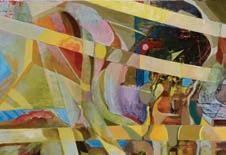

98



Even in remote Maui, Resta’s artistic sensibilities remained definitively European, with influences of Matisse and Chagall as in his “Architecture of Flight,” seen above, and “Ode to Eyptology,” seen on the following page.
ceramic panels depicting female figures in bright pastels grace a yellow stucco cabin. There’s a sculpture of a headless woman and a tall red vase standing on a plinth. “Resta Studios,” the stucco gate posts read. “Villa Tamarinda.” Beneath the signage, a tile features the timeworn outline of a yellow dog on a red field, like the seal of a Roman household.
This was the home of the late Italian artist Piero Resta. Here, in Maui’s wildlands, his art remained incongruously European: His faces alluded to the conciseness of Henri Matisse’s; his outlined figures harked back to the weightlessness and pliancy of Marc Chagall’s. Throughout his career, Resta produced over a thousand paintings, drawings and sculptures, first in a figurative style then later drawing from Cubism, Abstract Expressionism and geometric abstraction. “I’ve admired his fresh approach to painting, his deep devotion to Mother Nature, and his open attitude toward existence,” says Ida Panicelli, the editor of Artforum from 1988 to 1992. She visited Resta in the
early ’90s, and he gave her a painting of a sea goddess. “She has protected me since. I cherish her, her energy still resonates,” Panicelli says. While Resta’s works have dispersed across Maui and the world, his largest work—his sanctuary, his “cathedral without walls,” as he called it—is tucked back behind that stone wall.
A man, his gong and a pregnant woman appeared on Maui. Eight years earlier, the man had been living alone for a year in a driftwood hut on a sea cliff in Northern California, when he saw a woman in white on a dirt road. He thought she had come to him as a vision. Soon she began bringing him baskets of food. Piero Resta had found himself living inside a myth.
The year was 1970. The hut was two miles outside of Bolinas, just up the coast from San Francisco, then a hotbed of soul-searching hippies and poets. Soon Resta and the woman, Gail, started an avant-garde circus. Resta, the ringmaster, was a small man with
an appreciative smile who preferred loose, bohemian clothes and the coif of an early Beatle. They called themselves alternately the Now Primitives and Circo del Sol, wore capes and grotesque masks, rode horses and frolicked in the woods. When Gail found out she was pregnant, the couple sought out the ideal place a child could be born. She had always wanted to go to Hawai‘i. A friend told them to fly to Maui and hitchhike to Pā‘ia, where they met a bearded man playing ‘ukulele in a leopard-print Speedo and cowboy boots, who pointed them somewhere Gail could have the baby. She delivered a girl in the pool of a nearby waterfall. “My parents were real hippies,” says Bella Rosa Junglebird Flower Resta.
They took up in the jungle of Ha‘ikū, where Resta painted sporadically while dabbling in windsurfing and running restaurants. He loved parties and people, so he often made feasts for the house and struggled to turn a profit. The art began taking over his life anyhow, so he turned over the key to his landlord.
101
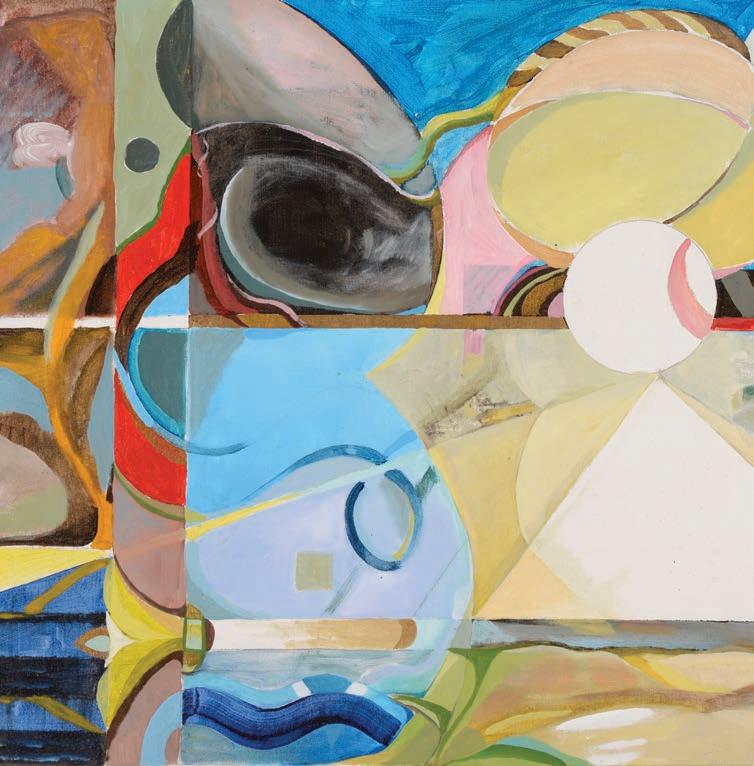
Resta had been keeping an eye out for land to buy, somewhere he would have more space and quiet. He read in a newspaper about a plot out in Kaupō that the owners were struggling to sell. It wasn’t an attractive prospect—it hadn’t rained there in quite some time. Resta and his son Luigi drove for an hour or two to the spot, then carved their way through the undergrowth with machetes.
They found stone walls and a tiered pit that resembled an amphitheater. “They realized these were the structures of Maui’s early inhabitants,” says his son Enzo Resta. “They had civilizations there.” Resta had found his place.
Two millennia ago Pliny and Ptolemy both wrote of the Roman colony of Iria, or Vicus Iriae, which
became Viqueria, then Voghera. Resta was born there, in what is now the north of Italy, on August 3, 1940. His father, Luigi, was a fighter pilot for Fascist Italy in World War II. His mother, Grazie Becagli, raised him with a half-brother. When Resta was four years old, his father’s plane was lost over Libya. “He was always kind of searching for answers,” Enzo says. “He
102
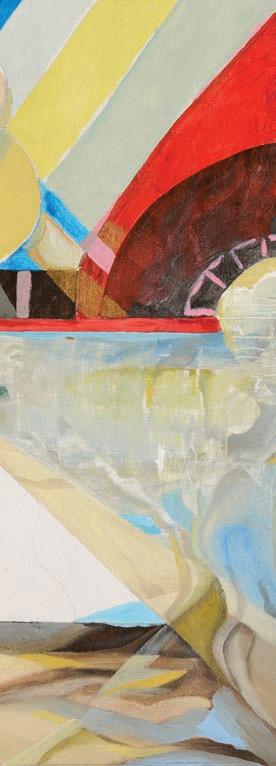
didn’t have a lot of choice as a child.”
Piero was sent to military school, then studied architecture in Florence.
Later he sought out London’s art scene, staying for six months and learning English. (Thirty-seven years later a British photojournalist named Paul Lowe sought Resta out and informed him that he was his son.) When Resta returned to Florence, he hawked




leather goods in a street market. One day he was sitting in a café wearing a scarf and reading a book of Federico García Lorca’s poetry, when he made eye contact with Susan Hewlett, an American college student abroad for the summer. In his passable English he asked her to take a walk with him. The walk turned into a long trip around Europe, and in 1963 they moved to Manhattan, to Chelsea. Two sons, Enzo and Luigi, soon followed. Resta worked as a photographer for L’Uomo Vogue, immersing himself in New York’s art scene. He showed paintings in group shows. He walked through Washington Square Park and was struck by Allen Ginsberg reciting poetry. In 1967 he photographed Gerard Malanga, the poet and assistant to Andy Warhol, alongside fashion model Cathy Damien. “He was a kind man with a simpatico nature,” Malanga recalls.
“And then he left on a journey with his art director,” Enzo says. Resta, many attest, was quite taken with women.
They were his artistic muse, the figures he painted most and his Achilles’ heel. Hewlett left for Bolinas with the kids, and eventually Resta followed. “He realized he wasn’t quite ready to leave it all behind,” Enzo says. Still, the two split up but remained friends. Resta began living in the driftwood hut, met Gail and ran the circus. In 1978 he moved to Maui while his sons stayed in Bolinas.
For Resta, art went hand-in-hand with food. He started Piero’s Garden Café in Pā‘ia, where he hosted poetry readings and concerts and his mother cooked Italian food, with a gallery space above the café. He and Gail opened a studio at the Pauwela Cannery in Ha‘ikū, where they sold art. Resta ran it like a workshop. Sometimes as many as five people in the studio worked on pieces he’d sketched. Gail made ceramics, fountains and columns.
As he acclimated to the island, he loaded his art with figures and bright colors. He embarked on a series, “Tropicana,” which drew heavily from
island imagery—palm trees and so on—but he kept it brief. “He didn’t really need to create romanticized Hawaiiana to sell paintings to tourists,” says Neida Bangerter, who met Resta at his restaurant and decades later curated a local retrospective of his work. “That wasn’t his thing at all. But he also was raising a family of a lot of kids, and he was a businessman.”
Resta worked under persistent financial pressure. “There were times when we had twenty bucks in the bank, and we would just look around and see what we had. And then we’d start making frescoes because all we had was cement,” Gail says. Resta made ends meet through a novel marketing strategy for his work: “The way we sold art was by entertaining,” Gail says.
At the time, windsurfing was growing more popular, and Maui’s consistent winds drew European devotees. The thing they missed most was the European culture of food and art, “so the studio and the dinners became their
105
Resta often referred to his home as a “villa without walls,” says his son, Enzo Resta. “The idea that without walls, it was in its most expansive state.” Above, one of Villa Tamarinda’s open-air rooms. On the following page, “The Dimensional Spirit of the Poet.”

culture,” Gail says. Apart from Native Hawaiian culture, “there was just not much else happening.” After Resta opened Piero’s—now Casanova—in Makawao, a restaurant and eventual social hub, he made a lifelong friend there in famed promoter Shep Gordon, who had managed Alice Cooper and Groucho Marx, among others. Gordon and a number of his friends began acquiring Resta’s art. “Most of my house is Piero’s stuff,” Gordon says. He has his paintings on the wall, sculptures in the
yard and custom tile around his jacuzzi. “Happy paintings,” he says. “It’s hard to describe why you like a painting. It’s like a song.”
In late spring the mock orange blooms in Kaupō. Honeybees visit the flowers. The smell, like jasmine, is vast and nostalgic. Resta’s black pickup truck is growing back into the grass. Here is an oasis, an extract of Italy with its olive trees and pastel stucco.
For some twenty-four years, in
between travels to Europe and the Mainland, Resta made his art here and entertained guests with wild parties. A cowboy on horseback used to check names at the gate, beyond which the yard winds through citrus trees with glazed ceramics scattered around the trunks—a face here, a wing there. An aging tent covers a table now strewn with glazed tiles, where Resta worked outside. Set farther back, an archway stands guard in front of a pavilion, resting on pillars colorfully painted and signed. The gong hangs, ready to be rung.
The pavilion—a kitchen without walls—rises up in tiers with tables that would have once been busy with food, wine and people. The multi-day affairs, which attracted Maui’s glitterati, verged on bacchic: At one party a bikini-clad woman covered with sushi lay on a table; guests plucked the food off her, recalls Resta’s friend Giovanni Cappelli. A disco ball still dangles from the ceiling next to big boxy speakers that once blared Pavarotti. “The parties were a marketing strategy,” Cappelli says. “People wanted to take a piece of him home with them, so they bought his art.”
On a desk, a notebook page shows Resta’s accounting: “Fontana 15,000 / Armonia 32,000 / Primavera 14,000 / Primavera 14,000 / Landscape 14,000 / Platter 900.” An old scrap of a price tag on a string reads, “Acrylic on Canvas 50x72 $26,000.00.” On another page Resta matched colors with their supposed healing properties: “turquoise = stimulates fisical body, circulation, vitalise nervous sistem … coral stimulate 1 + 2 cakra, spine blood energise hart,” and “perodot … prevents fear.” Resta believed art was “medicinal,” that just the right colors and forms could have “physiological and behavioral benefits to humanity,” Enzo says. He wanted his art to expand the viewer’s sense of self as well as his own. (Buddha figures and carvings of Hindu gods inhabit niches on the property.)
To the right of the pavilion, a path leads to the amphitheater where Resta
106


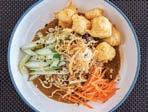

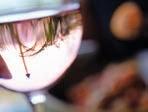

SEA-TO-TABLE CUISINE On Napili Bay VOTED BEST OCEANFRONT DINING Hours and More Information at SeaHouseMaui.com Celebrating Over 55 Years of Aloha at Napili Kai Beach Resort 5900 Lower Honoapiilani Rd • Napili • Maui • Hawaii 96761 • 808.669.1500 Breakfast • Lunch • Dinner • Happy Hour


“Entering
read poetry aloud; its semicircular tiers of lava rock are being reclaimed by the jungle. A stone stairway scales a grassy hill from the pavilion to “the bedroom,” an open-air structure with a freestanding bathtub in the grass. From the road the fragmentary signs of Resta’s world suggest something ancient, a halcyon Mediterranean idyll, but his inspiration had more primordial roots. “Piero thought of himself as a Roman,” Bangerter says. Cappelli, himself Italian, clarifies: “I would call him more of a Tuscan kind of guy than a Roman kind of guy, but Tuscan in terms of deep roots that go back even before the Romans.”
There aren’t many reasons to come to Kaupō anymore. Two churches remain. A rotting schoolhouse was recently rebuilt. The general store is shuttered; from time to time a makeshift tent in its yard sells snacks, make-the-drive-home drip coffee and leather goods. A woman operating the stand moved to Kaupō seven years ago for “nothing,” she says. “For the nothingness.” She had just missed Resta, who died in 2015 from cancer.
Another woman who used to run the store remembers him. “He wasn’t a recluse, but he was always busy, too, on the outside, going back and forth,” she says. The world beyond Kaupō—“that’s what we call the outside.” hh



109
At right,
the Golden Portal”; above right, “Let the Spirit Exalt.” Since Resta (seen above) passed in 2015, nature has begun reclaiming some of the grounds of Villa Tamarinda (above middle).
O ‘AHU EVENTS

H o MA NIGHTS
Every Friday and Saturday Honolulu Museum of Art remains open until 9 p.m. with opportunities to explore the galleries, stargaze in the courtyards, enjoy live art experiences and music and connect with the museum community. Honolulu Museum of Art, (808) 532-8700
110 ISLAND BY ISLAND : O‘AHU

DUKE’S OCEANFEST
8/20-28
A celebration of waterman, Olympian and ambassador of aloha Duke Kahanamoku. Festivities throughout the week include various lifestyle sports competitions and cultural, hula, film and music presentations. Waikīkī beach, (808) 221-6804
ALI‘I SUNDAY:KAMEHAMEHA ‘EKOLU (III)
8/7
A worship service in honor of Kamehameha ‘Ekolu (III) in a church that has strong ties to Hawai‘i’s royal past. The procession will begin at 9 a.m. Kawaiaha‘o Church, (808) 469-3000
ASIA PACIFIC DANCE FESTIVAL
8/1-14
Showcasing dancers and choreographers from Asia and the Pacific, the biennial festival presented by the University of Hawai‘i and the East-West Center returns with two weeks of concerts, courses and workshops. University of Hawai‘i at Mānoa, (808) 956-8246
40TH HAWAIIAN SLACK KEY GUITAR FESTIVAL: WAIKĪKĪ STYLE
8/13
A gathering of some of the greatest slack key musicians, this festival features five hours of musical performances, with local cuisine and crafters. 4 to 9 p.m. Waikiki Aquarium, (808) 226-2697
NĀ HULA FESTIVAL
8/7
Hawai‘i’s longest-running noncompetitive hula event, the festival brings together hālau (troupes) from around the state for a day of dance. 9 a.m. to 2 p.m. Free. Kapi‘olani Park, (808) 768-3041

40TH OKINAWAN FESTIVAL
9/3 & 4
Eat andagi (Okinawan fried dough), dress in traditional Okinawan bingata or paranku and participate in bon dancing at this popular annual festival organized by the Hawai‘i United Okinawa Association. The event is the largest ethnic festival in Hawai‘i and draws more than fifty thousand visitors from across the globe. Hawai‘i Convention Center, (808) 676-5400

REGGIE WATTS
8/20
Musician, comedian, writer and actor Reggie Watts uses voice, looping pedals and imagination to blend and blur the lines between music and comedy, creating performances that are 100 percent improvised. 8 p.m. Hawaii Theatre Center, O ‘ahu, (808) 528-0506
JAPANESE DESIGN: RINPA
Through 10/9
This exhibition explores the influence of Japanese design on international aesthetics. Honolulu Museum of Art, (808) 532-8700
TIG NOTARO
8/12
Comedian, actor, writer, producer, and director Tig Notaro performs her latest stand-up act Hello Again. 7 p.m. Hawaii Theatre Center, (808) 528-0506
BISHOP MUSEUM
AFTER HOURS
Every Second Saturday Museum exhibits are opened for viewing from 5:30 to 9 p.m., along with cultural demonstrations and food and drinks for sale from local vendors. Bishop Museum, (808) 847-3511
KĀNE‘OHE BAY AIR SHOW
8/13 & 14
An open house of Marine Corps Base Hawaii featuring flight demonstrations by the US Navy’s Blue Angels, the US Air Force’s F-22 Raptor Demonstration Team, a C-17 Globemaster and the Red Bull Air Force Team. Free. 10 a.m. to 4 p.m. Marine Corps Base Hawaii, O ‘ahu, (808) 257-1397
111
EAT / SHOP / PLAY
Asia Pacific Dance Festival

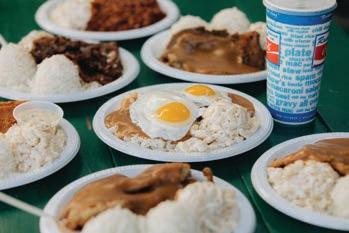
RAINBOW DRIVE-IN
Kapahulu, Kalihi, Pearlridge, ’Ewa, rainbowdrivein.com (808) 737-0177
Family owned since 1961, Rainbow Drive-In is known for their generous portions of simple, hearty Hawai‘i comfort food. Stop by one of four locations for the best Loco Moco or a delicious plate lunch. After enjoying a famous Slush Float for dessert, leave with one of our famous logo with one of our exclusive logo-emblazoned merch items from the Rainbow Tiki shop.

YOUNG'S FISH MARKET
Kapolei Commons, 4480 Kapolei Parkway, City Square, 1286 Kalani St, Honolulu youngsfishmarket.com (808) 841-4885
Home of the famous laulau! Young’s Fish Market has been Hawai‘i’s go-to for delicious local foods since 1951. Laulau, kalua pork, poke and more... We have everything to satisfy your Hawaiian food cravings. Want to send a taste of Hawai‘i to loved ones on the mainland? Send a Laulau Care Package delivered right to their door! Visit our website for information!

FISH MARKET & RESTAURANT EAT
EAT EAT / SHOP / PLAY ISLAND BY ISLAND : O‘AHU / PROMOTIONAL

88TEES
2168 Kalakaua Avenue, Honolulu 88tees.com
(808) 922-8832

88 Tees was established in 1988 with a simple belief: “Every Fit For Every Style.” Yaya, an iconic character, alongside her family embodies the Aloha spirit and lifestyle — sharing happiness and affection with others. Please join us at either of our two locations — one on Kuhio Avenue or our flagship store on Kalakaua Avenue, both in the heart of Waikiki.

FARMLOVERS FARMERS MARKETS
Kaka‘ako, Pearlridge Center, Kailua Town, Hale‘iwa farmloversmarkets.com (808) 388-9696

Immerse yourself in local food culture at any one of our Farmers Markets. Taste the true Hawai'i. Experience our local farmers, culinary masters, and artisans. Fresh locally grown produce. Tropical Fruits and Vegetables. Come Hungry! Leave Happy. Our chefs cook healthy, island style grindz. Need a Gift? Our local artisans have you covered. Kaka ’ako (Sat), Pearlridge (Sat), Kailua Town (Sun), Hale’iwa (Thur).
Paradise! Bring Home a Bite of
DOLE
dolefruithawaii.com

Bring Home a Bite of Paradise!


(800) 697-9100 Toll-Free (808) 847-3234 O’ahu

The exotic pineapple has been associated with Hawai’i & the DOLE® brand for over 100 years. The fertile, volcanic soils of O ‘ahu are kissed with Hawaiian sunshine, warm tropical rain, and gentle tradewinds, creating the sweeter, jucier DOLE Royal Hawaiian ® Pineapple.

HAWAIIAN RUGS®
O ‘ahu, Maui, Hawai ‘ i Island hawaiianrugs.com 808-524-7769

Celebrate the beauty of the Islands with Hawaiian Rugs® from Indich Collection. Our Hawaiian Rugs® are designed by local artists inspired by our rich flora and fauna. These quality rugs are then handcrafted by master weavers in Nepal and India using traditional materials and techniques that have been passed down through generations. Free shipping available with minimum purchase.
114
® TM & © Dole Food Company, Inc. 2022
ISLAND BY ISLAND : O‘AHU
SHOP
SHOP
EAT / SHOP / PLAY
SHOP

NORTH SHORE SOAP FACTORY
67-106 Kealohanui Street, Waialua Sugar Mill northshoresoapfactory.com (808) 637-8400
Watch what our Master Soap Maker is working on when you visit North Shore Soap Factory! Come for the soap, stay for the stamping…customize your bar at our Stamping Station. Book a Behind-the-Scenes Tour* to see how we handcraft Hawaiian Bath & Body® soaps and skincare. Local art, gifts and more. Find us in the Big Coneshaped building!
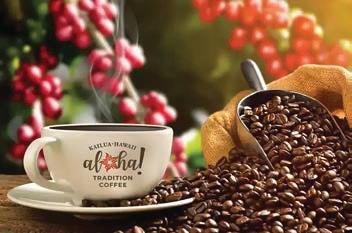
TRADITION COFFEE ROASTERS
905 Kalaniana’ole Hwy, #3201, Kailua TraditionCoffeeRoasters.com 808-207-7022

Discover what makes good coffee, how to brew your best cup and bask in the smell and taste of fresh roasted coffee. Tour the Roastery, take a coffee sensory class or just come and enjoy your best cup of coffee on island! Open to the public for guided tours, free tastings, classes, retail and shopping our coffee beans and brewing supplies.

PROMOTIONAL
North Shore
Factory SHOP
Soap
SHOP
O ‘AHU EVENTS
14TH HUBB’S KEIKI FEST
8/13
A children’s boogie-boarding competition focused on creating ocean awareness, cultural connection and fostering the competitive spirit. 7 a.m. to 3 p.m. Free. Sherwood Beach, 808635-2435
BEYOND THE SPORT SCREENING AND PANEL
9/24
The documentary debut of the legendary surf champ who helped revolutionize that sport in 1960s Hawai‘i, Joey Cabell: Legend of Surf, tells the story of the ultimate renaissance man—a worldclass sailor, skier, and entrepreneur who launched the famous "Chart House" restaurant brand. 5 p.m. Hawaii Theatre. (808) 528-0506
ERIC NAM
9/1 & 2
Singer, songwriter and television host Eric Nam performs songs from his new album There and Back Again. The Republik, (808) 941-7469
JERSEY BOYS
9/13-25
This Tony Award-winning musical dramatizes the formation, success and eventual breakup of the 1960s rock 'n' roll group the Four Seasons. Blaisdell Concert Hall, (808) 768-5252
NAPOLEON DYNAMITE FILM & PANEL
9/16
A full screening of the film Napoleon Dynamite, followed by a moderated discussion with fan-favorite cast members; Jon Heder (Napoleon Dynamite), Efren Ramirez (Pedro) and Jon Gries (Uncle Rico). Event is BYOT (Bring Your Own Tots). 7 p.m. Hawaii Theatre Center, (808) 528-0506
69TH WAIKĪKĪ HO‘OLAULE‘A
9/17
Thousands of people gather on Kalākaua Avenue for food, fun and entertainment as part of this year’s Aloha Festivals. Hawaiian musicians and hula hālau perform on stages set up along the street. Hawaiian crafts, lei and Island cuisine are offered throughout the event. 6 to 9:30 p.m. Kalākaua Avenue, (808) 923-1094
ACOUSTIC HOT TUNA
9/30
Started as a side project during Jefferson Airplane days, musicians Jorma Kaukonen and Jack Casady perform as Hot Tuna, one of the most enduring partnerships in rock history. 8 p.m. Hawaii Theatre Center, (808) 528-0506

BATTLESHIP MISSOURI MEMORIAL
Arizona Memorial Place, Honolulu ussmissouri.org 808-455-1600

PLAY
Complete your Pearl Harbor Experience. The USS Missouri is no ordinary ship, this is America’s most historic battleship. Home to 2700 Sailors, nine 66-foot-long guns, 1220 projectiles and a deck big enough to host a surrender ceremony presided by General Douglas MacArthur. Shuttle service from the Pearl Harbor National Memorial visitors center included with admission.

WAIMEA VALLEY
59-864 Kamehameha Hwy., Hale’iwa waimeavalley.net 808-638-7766

Waimea Valley is a wahi pana (storied place) deeply rooted in Hawaiian culture. Today Waimea is home to six cultural sites and 5,000 unique plants from all over the world. Allow the wonders of Waimea to speak to you as you walk through this place of healing. Experience the tranquility and the sites that harken back to a bygone era in Hawai‘i’s history.
116 ISLAND BY ISLAND : O‘AHU / PROMOTIONAL EAT / SHOP / PLAY

HAWAI ‘ I ISLAND EVENTS
NIAULANI NATURE WALK
Mondays
A one-hour nature walk through an old-growth Hawai‘i rainforest on an easy loop trail. Walkers are introduced to the native plants and birds of Kīlauea volcano. Free. 9:30 a.m. Volcano Arts Center’s Niaulani Campus, (808) 967-8222
PORTUGUESE BREAD BAKING
Thursdays
Observe the traditional art of baking Portuguese bread in a large wood-fired stone oven, or forno. The programs team will share the importance of such ovens in the community and the history of the Portuguese; bread sales begin at 1 p.m. 10 a.m. Kona Historical Society, (808) 323-3222
A WALK INTO THE PAST
Fridays
Take a walk back in time to 1912 and meet the founder of the Hawaiian Volcano Observatory, Thomas A. Jaggar, at the edge of Kīlauea volcano. Dressed in period costume, Ka‘ū actor and director Dick Hershberger brings the renowned geologist to life. Free. 10 a.m. to noon. Hawai‘i Volcanoes National Park, (808) 985-6000
FREE ADMISSION DAYS
8/4 & 9/24
For the anniversary of the Great American Outdoors Act and National Public Lands Day, Hawai‘i Volcanoes National Park will be offering free admission all day—passes are normally $10 to $15. Consider calling ahead of time to check on current park conditions. Hawai‘i Volcanoes National Park, (808) 985-6000
61ST HAWAIIAN INTERNATIONAL BILLFISH TOURNAMENT
Through 8/7
Teams from around the world compete to catch Pacific blue marlin for cash prizes and the chance to win the coveted HIBT Governor’s Trophy. Kailua-Kona, (808) 326-7820
QUILTS IN THE FOREST: LOOKING FORWARD HONORING THE PAST
Through 8/14
This semi-annual quilt show displays the talent of Hawai ‘ i Island quilters, both amateur and professional. Free. Volcano Arts Center’s Niaulani Campus, (808) 967-8222
HALEKI‘I FARMERS MARKET & CRAFT FAIR
Every First Saturday
Local crafts and art vendors, keiki entrepreneurs, fresh food, ‘ohana-centered outreach, sustainable-living resources and live music every first Saturday of the month. Free. 9 a.m. to 2 p.m. Kona Grill House, (808) 960-7728
KŌKUA KAILUA VILLAGE STROLL
8/21
Ali‘i Drive transforms into a festive, pedestrian-only marketplace filled with music and art. At 4 p.m. there is a free Hawaiian-music concert at Hulihe‘e Palace. 1 to 6 p.m. Kailua-Kona, (808) 936-9202
QUEEN LILI‘UOKALANI CANOE RACES
9/1-5
The largest long-distance canoe race in the world attracts dozens of canoe clubs and hundreds of paddlers from Hawai‘i and beyond. This five-day event also includes a cultural festival, parade, fair, lū‘au and food booths. Kona, (808) 937-3255
HILO BAY 5K AND 10K
9/13
Big Island Road Runners’ longest running event. The route for both races includes Lili‘uokalani Park and Hilo bayfront. Participants in both races will get t-shirts and post-race refreshments as well as age group awards. 7:30 a.m. Reed’s Bay Park, (808) 464-0333
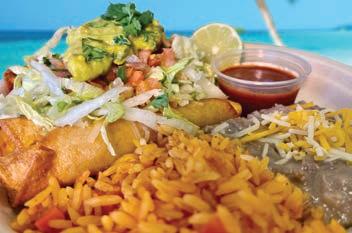
PATRICIO’S MEXICAN TAQUERIA
73-4038 Huliko ‘a Drive, Kailua-Kona patriciostaqueria.com (808) 334-1008

Whether you’re new to the Island or a seasoned local, count on us to fill your craving for fresh and authentic Mexican food. Delicious House Specialties include Chile Rellenos, Tamales, Taquitos, and Enchiladas. Located only 1 mile from Kona International Airport. Get your beach snack or family dinner with us! Open daily from 10:30-8:00pm. View the full menu at patriciostaqueria.com
118 ISLAND BY ISLAND : HAWAI ‘ I ISLAND
EAT
EAT / SHOP / PLAY
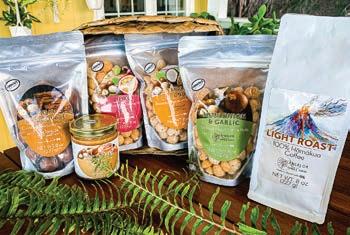

Ā HUALOA FAMILY FARM
45-3279 Mamane Street, Honoka’a ahualoafarms.com (808) 775-1821

Stop by “The Nuthouse” and see what’s crackin'! Ā hualoa Family Farms grows, processes, and produces delicious 100% Hawaiian macadamia nuts and 100% Hamakua coffee in Historic Honoka’a town, the gateway to Waipio Valley. Come in for free samples, relax on the lanai, enjoy a cup of coffee and take home your favorite macadamia nut flavor. See you at The Nuthouse!
‘IMILOA ASTRONOMY CENTER
University of Hawai‘i at Hilo 600 ‘Imiloa Place, Hilo imiloahawaii.org (808) 932-8901


KONA
SALT FARM BY SEA SALTS OF HAWAI ‘ I
73-907 Makako Bay Drive, Kailua-Kona seasaltsofhawaii.com (808) 326-9301
Visit Hawai ‘ i Island’s only working salt farm. Located on a beautiful 7-acre oceanfront site, we handharvest Hawaiian Salt from ultrapristine deep ocean waters. Learn about our harvesting process and the significance of salt in Hawaiian culture. Book your tour at www.konaseasalt.com or visit our salt farm store. Minutes from the Kona International Airport.
PLAY
Visit ‘Imiloa in Hilo, Hawai‘i, and explore the science of Hawai‘i! Immerse yourself in our Planetarium and interactive Exhibit Hall and take a walk through our native Hawaiian garden landscape. We are an ideal venue for group tours, educational field trips and event hosting. Don't forget to ask about membership discounts too!

VOLCANO ART CENTER
Hawai ‘ i Volcanoes N ational Park, Volcano Village volcanoartcenter.org (808) 967-8222

The Volcano Art Center promotes, develops, and perpetuates the artistic, cultural, and environmental heritage of Hawai‘i through art and education. The Niaulani Rain Forest provides a wonderful experience for visitors to learn about Hawai‘i’s rare, old-growth forests. Free guided tours Mondays at 9:30am and the Forest Fair on October 8th are supported by Hawai‘i Tourism Authority.
PROMOTIONAL
SHOP
119
PLAY
MAUI EVENTS
UPCOUNTRY FARMERS
MARKET
Saturdays
Locally grown produce, fish, prepared food and products. Free. 7 to 11 a.m. Kula Malu Town Center, (808) 572-8122
PAPER WATER WIND
Through 8/20
This invitational exhibition features artists who explore the themes of water and wind through the medium of paper, deploying and altering its materiality with methods of printing, painting, folding, shredding and stitching. Maui Arts & Cultural Center (MACC) Schaefer Gallery, (808) 242-2787
MAUI SUNDAY MARKET
Sundays
A weekly evening marketplace with local food and product vendors and live entertainment, organized by the Maui Food Technology Center. Free. 4 to 8 p.m. Kahului Shopping Center, (888) 948-6382
WHITE HAWAIIAN: ERIC GILLIOM’S ONE-MAN SHOW
8/12-14
An entertaining autobiographical stageshow that covers the career of Eric Gilliom, his Maui upbringing as a Caucasian with Hawaiian roots and the TV, film and Broadway roles that have given him hilarious stories to share. ProArts Playhouse, (808) 463-6550


NEON BEATS SILENT DISCO
8/18
A monthly silent disco with multiple DJs and channels available for a personalized outdoor dance party. Beverages available and $5 headphone rental fee. 10 p.m. to 1 a.m. Down the Hatch, (808) 661-4900
QKC KEIKI CLUB
8/20
Learn about the vast diversity of sea life in Hawai‘i with one of Maui Ocean Center’s marine naturalists at the QKC keiki play area. Enter to win giveaways and enjoy family-friendly festivities. 10 to 11 a.m. Queen Ka‘ahumanu Center, (808) 877-3369
THE IKAIKA NUI EXTREME OBSTACLE CHALLENGE
8/20
A one-mile obstacle course consisting of a trail run, water slide, mud, color, ice and other themed obstacles for individual and relay teams. There will also be a keiki mile for those under twelve years old, as well as music and bouncy castles at the finish line. 7:30 a.m. Kapalua, (808) 280-5801
KAULUHIWAOLELE MAUI FIBER ARTS CONFERENCE
8/31-9/3
Master weavers share their knowledge and skills of ancient Hawaiian weaving and discuss how Hawaiian plants can be used in multiple ways to create art. Registration needed to attend. During the conference, a craft fair and mini-workshops will be open to the general public. Kā‘anapali Beach Hotel, (808) 661-0011
FESTIVALS OF ALOHA— BANYAN TREE HO‘OLAULE‘A
9/3
The Festival of Aloha, Maui Nui Style kicks off a two-month celebration on Maui, Lāna‘i and Moloka‘i with the Banyan Tree Ho‘olaule‘a at Keawaiki Park. Exhibits, keiki activities, local food, Maui-made arts, Hawaiian music and hula will be available from 9 a.m. to 5 p.m. Free. Keawaiki Park, Lāhainā, (808) 264-8779
MOON FESTIVAL TALK
9/7
Presentation by the cultural director of Wo Hing Museum, Busaba Yip, on the history of moon festivals in China and around the world, as well as displays of traditional harvest offerings to the moon goddess and Chinese lanterns. Free. 9:30 a.m. Lāhainā Library, (808) 661-3262
CHINESE MOON FESTIVAL
9/16 & 17
Lāhainā’s Wo Hing Museum presents a traditional Chinese moon festival during the first full moon of harvest season. Enjoy foods like moon cakes, cooking demonstrations, live music played on traditional instruments, cultural art demos including calligraphy and children’s crafts. 10 a.m. to 7 p.m. Free. Wo Hing Museum, (808) 661-3262
120
ISLAND BY ISLAND : MAUI
Chinese Moon Festival
EAT / SHOP / PLAY
Festivals of Aloha

Wildlife Wednesdays
WILDLIFE WEDNESDAYS
Wednesdays
Join naturalists from the Hawaiʻi Wildlife Discovery Center at the beachfront every Wednesday morning and learn all about humpback whales, turtles, monk seals and more Maui wildlife. 10 a.m. to noon. Whalers Village, (808) 661-4567
HĀNA FARMERS MARKET
Fridays
Locally grown produce and products from farmers in the East Maui communities of Ke‘anae, Hāna, Kīpahulu and Kaupō. Online pre-orders and drive-through ordering available. Free. Kūpuna-only (65+) shopping starts at 2:30, general admission from 3 to 5 p.m. Hāna Town Center, (808) 378-0084
MĀLAMA WAO AKUA 2022
9/10-11/5
A juried art exhibition of all media celebrating the native species of Maui Nui (Maui, Lāna‘i, Moloka‘i, Kaho‘olawe). Maui artists explore watersheds and raise awareness about the importance of protecting native species. Hui No‘eau Visual Arts Center, (808) 572-6560
UPCOUNTRY FARMERS MARKET
Saturdays
Locally grown produce, fish, prepared food and products. Free. 7 to 11 a.m. Kula Malu Town Center, (808) 572-8122
21ST FRONT STREET MILE, 5K AND 10K
9/17
This flat, out-and-back course along the Lāhainā shoreline is one of the most popular races on Maui. Ease of course and scenic views makes this a great race for runners of all ages and experience levels. Medals for all finishers. Presented By Tommy Bahama Marlin Bar. Lāhainā, (808) 280-5801
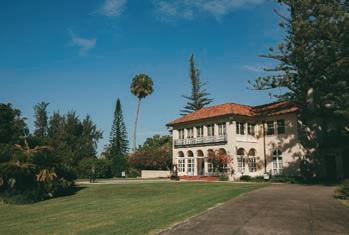
HUI NO‘EAU VISUAL ARTS CENTER
2841 Baldwin Avenue, Makawao, Maui huinoeau.com 808-572-6560

Located in Upcountry Maui at the historic Kaluanui Estate, Hui No‘eau Visual Arts Center is a nonprofit, community arts center offering art classes, workshops, exhibitions, and events. Visitors are invited to explore the 100-year-old Kaluanui home, enjoy artwork by local artists in the gallery and gift shop, or take a self-guided tour of the scenic 25-acre grounds.
QKC KEIKI CLUB
9/17
Learn about the vast diversity of sea life in Hawai’i with one of Maui Ocean Center’s marine naturalists at the QKC keiki play area. Enter to win giveaways and enjoy family-friendly festivities. 10 to 11 a.m. Queen Ka’ahumanu Center, (808) 877-3369
FESTIVALS OF ALOHA, ALOHA FRIDAY
9/23
Welcome in the weekend with Hawaiian cultural practitioners sharing their art as well as music, dance, crafters and ’ono food. 6 to 9 p.m. Queen Ka’ahumanu Center, Kahului, (808) 264-8779
FESTIVALS OF ALOHA, RICHARD HO’OPI’I FALSETTO CONTEST
9/23
Held in honor of Uncle Richard Ho’opi’i, one of Hawai’i’s most beloved and talented musicians, this singing competition showcases some of Maui’s finest amateur male falsetto performers. 5:30 to 9:30 p.m. The Ritz-Carlton Kapalua, (808) 280-8098
PLAY PROMOTIONAL
121
KAUA‘ I EVENTS
MAKAI MUSIC & ART FESTIVAL
Wednesdays
A weekly gathering with performances by local musicians and an assortment of handmade jewelry, crafts, art and more from local vendors. Free. 1 p.m. to 5 p.m. Makai Lawn, Princeville (818) 318-7338
HANALEI FARMERS MARKET
Saturdays
Locally grown fruits and vegetables from Kaua‘i North Shore farmers, along with fresh-squeezed juices, locally-made honey, fresh-baked goods and arts and crafts. 9 a.m. for senior citizens, 9:30 a.m. to noon for general admission. Hale Halawai ‘Ohana O Hanalei, (808) 826-1011
ALAKOKO PLANT SWAP
Sundays
This weekly market offers plant lovers the chance to buy, sell or trade a wide variety of greenery. Free. 10 a.m. to 1 p.m. Alakoko Shop, (808) 652-1442
PAU HANA TRIVIA NIGHT
8/5
A family-friendly trivia night in Porter Pavilion with food trucks, beer and wine hosted by Katie C. Kaua‘i’s “trivia girl.” Free. 6 to 8 p.m. Anaina Hou Community Park, (808) 828-2118
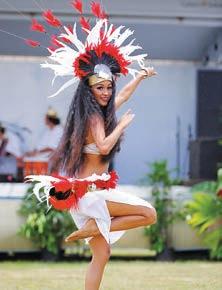

PRINCEVILLE ARTIST AND FLEA MARKET
8/6
This monthly marketplace focused on vintage apparel, accessories and home goods also features local vendors offering crafts, jewelry, health products, food, a keiki zone and live music. Free. 3 to 7 p.m. Princeville Community Center, (808) 826-6687
HEIVA I KAUA‘I
8/6&7
A two-day festival that showcases Tahitian culture, featuring Tahitian dance and drum groups and soloists competing in traditional and contemporary styles. Crafts and food vendors sell a wide variety of food and gifts. Runs from 9 a.m. to 5 p.m. Kapa‘a Beach Park, (808) 822-9447
MUSIC & MANGO FESTIVAL
8/7
The Waipā Foundation’s Music & Mango Festival includes live music, hands-on activities, artisans and crafts, contests and food inspired by the summer mango harvest. 11 a.m. to 5 p.m. Waipā Community Complex, (808) 826-9969
DOWNTOWN LĪHU‘E NIGHT MARKET
8/13
Locally made crafts, gifts, food trucks, baked goods, live entertainment and more. Featuring more than fifty vendors each month. Free. 4 to 8 p.m. Kress Street, Līhu‘e (808) 652-1442
KAUA‘I MARATHON
9/4
Participants in the Kaua‘i marathon and half-marathon pass hula dancers and taiko drumtroupes along the course while viewing striking mountain vistas. 6 a.m. to 2 p.m. Po‘ipū, (808) 283-2078
BATTLE OF THE FOOD TRUCKS
9/11
Food trucks battle to be named Kaua‘i’s best. Each truck is given several local ingredients and challenged to create a savory and a sweet dish for sale. Attendees can taste them all and vote for their favorites. 2 to 6 p.m. Kress Street, Līhu‘e (808) 652-1442
HAWAI‘I LINE DANCE FESTIVAL
9/16&17
This fundraiser for the Kaua‘i Veterans Center and Museum offers a chance to kick up your heels with open line dancing, dance workshops, performances and prizes. Saturday will include food trucks and a craft fair. Friday 5 to 10 p.m., Saturday 10 a.m. to 10 p.m. Kaua‘i Veterans Center and Museum, (808) 246-1135
OLD KŌLOA TOWN MARKET
9/17
Kaua‘i artisans, photographers, food trucks, food vendors, musicians and entertainers gather for this monthly makers market. Free. 4 to 8 p.m. Old Kōloa Town, (808) 245-4649
122
ISLAND BY ISLAND : KAUA ‘ I
Heiva i Kaua‘i
EAT / SHOP / PLAY
Kaua‘i Marathon

ELE KAUA ‘ I
@elekauai
Kaua ‘ i, Oahu, Maui, Hawai ‘ i Island www.elekauai.com (808) 346-6020

Transport yourself to the gorgeous islands of Hawai ‘ i, all without leaving the comfort of your home! Ele Kaua ‘ i is passionate about creating highquality candles, air mists, body scents, bath salts, and more that will fill your space with the aroma of the Hawaiian islands. Made by hand with aloha on the North Shore of Kaua ‘ i, visit their website for more information.

KELA'S GLASS GALLERY
4-1400 Kuhio Highway, Kapa ‘a, Kaua ‘ i www.glass-art.com (808) 822-4527

ART KAUA‘I
9/17-10/28
Art Kaua‘i is the annual juried show of the Kaua‘i Society of Artists, featuring works in multiple media by a distinctive group of artists living on the island. Kukui Grove Shopping Center, (808) 245-2782
KAUA‘I MOKIHANA FESTIVAL
9/18-24
This week-long celebration of contemporary Hawaiian culture is known for its authenticity and friendly hospitality. The festival includes a Kaua‘i composers contest, a children’s music competition and a three-day hula competition. The festival is one of the major events of the year on Kaua‘i. Various locations around the island, (808) 651-1868
MAKANA WAIPĀ: EAT THE INVASIVES
9/24
Waipā Foundation's major annual fundraiser. Chefs from O‘ahu and Kaua‘i gather with the community to celebrate the bounty of Waipā and enjoy innovative dishes highlighting invasive plants. Waipā Community Complex, (808) 826-9969
At Kela’s Glass Gallery, it’s all about the glass art. See for yourself the stunning Color Changing Jewelry by the owner Mimi. This impressive gallery features the works of over 150 fine glass artists. Apparently the specialization works. Kela’s Glass Gallery won the prestigious Top Retailer Award from NICHE Magazine voted on by over 10,000 American artists.
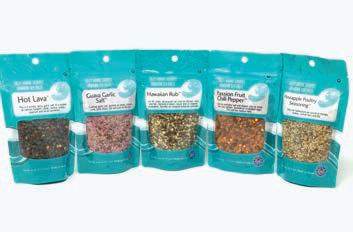
SALTY WAHINE GOURMET HAWAIIAN SEA SALTS
1-3529 Kaumualii Highway, Unit 2B Hanap ē p ē saltywahine.com (808) 378-4089

Salty Wahine Gourmet Hawaiian Sea Salts is a family-owned Kaua ‘ i Made Company that specializes in Kosher Hawaiian Sea salts, seasonings, and tropical sugars using fruit infusions like mango, coconut, guava, passionfruit, dragonfruit, and pineapple. All products are made by hand with Aloha in our Salty Wahine commercial kitchen/factory in Hanap ē p ē , Kaua ‘ i. Salty Wahine’s goal is “making eating healthy and fun”.
EAT PROMOTIONAL
SHOP SHOP
123
SHOP
MORE ISLAND EVENTS
SUMMER CRAFT FAIR
8/5 & 6
Local artists and crafters exhibit handmade works. 10 a.m. to 6 p.m. Prince Kuhio Plaza, Hawai ‘ i Island, (808) 959-3555
NEW KIDS ON THE BLOCK FEATURING TLC
8/5-7
Boy band New Kids on the Block is heading to Hawai‘i for the first time in three decades for three nights of ’90s nostalgia featuring special guests TLC. 8 p.m. Blaisdell Arena, (808) 768-5252
MANA 10S RACES
8/12
A 10k and 10-mile race through Waimea town via Mana Road sponsored by Big Island Road Runners. 7:30 a.m. Waimea, Hawai ‘ i Island
KŌKUA KAILUA VILLAGE STROLL
8/21
Ali‘i Drive transforms into a festive, pedestrian-only marketplace filled with music and art. At 4 p.m. there is a free Hawaiian-music concert at Hulihe‘e Palace. 1 to 6 p.m. Kailua-Kona, Hawai ‘ i Island, (808) 936-9202
HAWAIIAN MUSIC SERIES: MATAGI TRIO
8/25
Meaning “wind” in Samoan, matagi is also the name for the trio of Maui musicians Marvin Tevaga, Kalani Miles and Kimo Brehm, who perform a variety of musical styles. Limited seating is provided. Blankets, mats and low beach chairs are welcome. Free. 6 to 7:30 p.m. Baldwin Home Museum, Maui, (808) 661-3262
EMMA FARDEN SHARPE
HULA FESTIVAL
8/27
An invitational hula event honoring kumu hula Emma Kapiʻolani Farden Sharpe, featuring hula performances, cultural

The Healer Stones of Kapaemahu
workshops, historical exhibits and artisan crafts. 9 a.m. to 5 p.m. Lāhainā Banyan Tree, Maui, (808) 264-8779
CROSS POLLINATION: FLOWERS ACROSS THE COLLECTION
Through 6/4/2023
Presented in conjunction with the immersive anchor installation Rebecca Louise Law: Awakening, this exhibition unites a diverse arrangement of floral artworks from HoMA’s permanent collection. Honolulu Museum of Art, (808) 532-8700
ALOHA FESTIVALS ROYAL COURT INVESTITURE & OPENING CEREMONY
9/10
An opening ceremony kicks off the annual Aloha Festivals. Ali‘i Court members receive their royal cloaks, helmets, head feather lei and other symbols of their reign amid traditional hula and chants. 4-6 p.m. Helumoa Gardens at Royal Hawaiian and Royal Grove at Royal Hawaiian Center, O ‘ahu, (808) 923-1094
THE HEALER STONES OF KAPAEMAHU
Through 10/16
An exhibit exploring the past and contemporary meanings of four large stones that were long ago placed on Waikīkī Beach to honor four māhū, extraordinary individuals of dual male and female spirit, who brought healing arts from Tahiti to Hawai ‘ i. Bishop Museum, O ‘ahu, (808) 847-3511
46TH ANNUAL HONOLULU INTERTRIBAL POWWOW
9/10-11
This annual festival of Native American culture features local and Mainland Native American arts and crafts vendors, craft activities for kids and educational booths along with dance concerts, drumming and singing. 10 a.m. to 5 p.m. Bishop Museum, O ‘ahu, (808) 847-3511
KAUA‘I CULINARY MARKET
Wednesdays
A weekly farmers market featuring fruits, vegetables, flowers and a cooking demonstration. A partnership with the Kaua‘i County Farm Bureau. 3:30 to 6 p.m. The Shops at Kukui‘ula, Kaua ‘ i, (808) 742-9545
124
ISLAND BY ISLAND : EVENTS EAT / SHOP / PLAY




Aloha
Welcome aboard
luana i ka lele ‘ana. E lawelawe mākou iā ‘oe me ka ha‘aha‘a.
In Hawaiian culture, mea ho‘okipa means "I am your host." This phrase expresses the spirit of hospitality you'll find on our flights, whether you're traveling to the Neighbor Islands, between Hawai‘i and North America or within the Asia-Pacific region. If there is anything that we can do to make your flight more enjoyable, please don't hesitate to let us know.
128 / In-Flight Meals
129 / Streaming Entertainment on A321neo Aircraft
130 / In-Flight Snacks, Souvenirs and Beverages
132 / Terminal Maps
134 / HawaiianMiles Partners
136 / Route Map
138 / The ‘Ohana Pages
E
ALOHA FROM HAWAIIAN AIRLINES 127
In-Flight Tastes of Hawai‘i
Delicious Complimentary Meals
It’s true. We’re one of the only airlines left in the country to serve you a complimentary meal at mealtime in the Main Cabin. You’ll find Hawai‘i-inspired meals on select flights to and from Hawai‘i, always served with our unique brand of Hawaiian hospitality.


Above top: Wade Ueoka and Michelle Karr-Ueoka
Bottom: Chuck Furuya
Left to right: Chef Eric Oto of Hoku's at the Kahala Resort and Spa, Chef Robynne Maii of Fete Hawaii, Chef Dell Valdez of Vein at Kaka‘ako, Executive Chefs Wade Ueoka and Michelle Karr-Ueoka of MW Restaurant, Chef Chris Kajioka of Miro Kaimuki and Chef Jason Yamaguchi of Mugen Waikiki.
Hawaiian Airlines Featured Chef Series showcases star chefs
Hawaiian Airlines’ in-flight service shares the sights, sounds and tastes of Hawai‘i, and when it comes to our First Class meal service, that means exciting, varied Pacific Rim cuisine with our Featured Chef Series. This esteemed collaboration showcases some of Hawai‘i’s most dynamic chefs creating menus for meals served in our forward cabin.
The Featured Chef Series is overseen by Hawaiian Airlines Executive Chefs Wade Ueoka and Michelle Karr-Ueoka.
Sit back and enjoy Hawai‘i’s vibrant food culture and our distinct onboard experience.
A taste of tradition
Executive Chefs Wade Ueoka and Michelle Karr-Ueoka opened MW Restaurant in Honolulu in 2013. Their cuisine combines inspirations from travels around the world with Hawai‘i’s culinary traditions and local bounty. To sample MW’s latest creations visit their new location at 888 Kapi‘olani Boulevard in Honolulu.
MWRestaurant.com
Wine pairings by our Master Sommelier
Chuck Furuya has a passion for the world’s oldest fermented beverage and holds the distinction of becoming only the tenth person in the United States to pass the rigorous Master Sommelier examination, in 1988. You can find Chuck at Chuck Furuya Uncorked on YouTube.

HO‘OKIPA
128
In-Flight Entertainment on A321neo Aircraft
Streaming Entertainment to Personal Devices
Guests on our new A321neo aircraft are able to stream complimentary inflight entertainment on their personal electronic devices. We offer a wide selection of movies, TV shows and music as well as Hawaiian Airlines’ own exclusive programming.
Viewing on Smartphone or Tablets (Apple iOS or Android only)*
1. To enjoy all the movies and TV selections you must download the Hawaiian Airlines app.
2. Once onboard:
• Switch to Airplane Mode
• Connect to the wifi network “HawaiianAirWifi”
3. After connecting to wifi network, open Hawaiian Airlines app:
• Select More
• Select In-Flight Entertainment
Note: For iOS users, Select “Ok” when prompted to connect your device to Hawaiian Airlines local network. Supported on iOS 12.5 or higher, and on Android 8.0 or higher.
Viewing on a Laptop
1. Connect to wifi signal "HawaiianAirWiFi"
2. Open one of the supported browsers— Google Chrome (ver. 58+), Apple Safari, or Firefox (ver. 69+)—and type in URL: HawaiianAirlinesWiFi.com
*Available only on A330 and A321neo aircraft.
3. Choose from the menu of entertainment selections and enjoy!
4. Please note: Internet Explorer and Edge browsers are not supported browsers at this time. Supported computer operating systems include MacOS X 10.10-10.14 or Windows 7-10 (Windows 8 must be in desktop mode.)
Having trouble accessing the entertainment? Try these general troubleshooting steps:
1. Is your WiFi signal on? Double-check device settings to ensure airplane mode is on but WiFi is available.
2. Ensure you are connected to the WiFi network: HawaiianAirWiFi. You may need to disconnect and reconnect to wifi network to re-establish secure connection.
3. On a mobile device, make sure you are using the latest version of the Hawaiian Airlines app.
4. It may be helpful to close and relaunch the Hawaiian Airlines app after connecting to WiFi network.
Mele
Collections to suit your musical tastes
Hawaiian Airlines offers DJ-hosted, curated audio programming devoted to musical styles from across the globe, ranging from award-winning Hawaiian music to jazz and K-Pop.*
FEATURED CHANNELS INCLUDE:
Island Favorites
From the latest songs to all-time classics, Island Favorites presents the best of Hawaiian musicians, including Ho‘okena, Chad Takasugi, Pōmaika‘i and others.
Hawaiian Legacy Favorites
A nostalgic tour of music from Hawai‘i’s territorial and early-statehood eras, featuring artists like the Makapu‘u Sand Band, Myrtle K. Hilo and Kawai Cockett.
Declaration of Independents
Host Rodger Bong curates this worldspanning survey of independent artists, including Tyrone Henry, Dorotheo and Weirdest Dream.
Wings of Jazz
A gathering of Hawai‘i’s top jazz artists, including Dan Del Negro, Nueva Vida, the Steve Jones Collective and Gabe Baltazar.
These and more special audio programs can be found in the Radio category available in our onboard in-flight entertainment systems.


129 HO‘OKIPA
Chad Takasugi (left) and Pōmaika‘i (right)
In-Flight
Snacks and Souvenirs

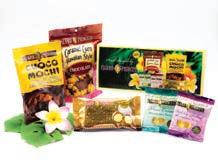
in Hawai‘i Snack Sampler

Pau Hana Snack Cart
Blanket and pillow set, popular local snacks, souvenirs and sundries are available from the Pau Hana Snack Cart. Cabin crew will advise when the cart is heading down the aisle on domestic flights or is open in the galley on Australia and New Zealand flights.
Selections and quantities are limited and may vary. To print receipts of in-flight purchases, visit HawaiianAirlines.com/receipts.
Popular Local Snacks
Mananalu Water in Aluminum Bottle, 16 oz.**
Hawaiian Chip Company Taro and Sweet Potato Chips
Island Princess Caramel Macadamia Nut Popcorn
Kona Chips Furikake Chips
Samurai Furikake Popcorn
Snack Packs*
Made in Hawai‘i Snack Sampler K
Choco Caramel Popcorn, Choco Mochi, Lightly Salted and Maui Onion Macadamia Nuts, Mele Mac
Classic Snack Box GF Crackers, Cookie, Chickpeas, Turkey Stick, Hummus, Gummies
Keiki (Child) Snack Box GF Cheese Puffs, Granola Minis, Turkey Stick, Applesauce, Gummies, Cookie
‘Ono Snack Box GF Salami, Cheese Spread, Dried Fruit, Olives, Crackers, Cookie
Cheese Tray with Crackers and Dried Fruit
Classic Snacks
M & M's Peanut
Maruchan Cup Ramen Chicken
Pringles K
Sundries
Ear Buds with Hawaiian Airlines Zipper Case**
Hawaiian Airlines Blanket and Pillow Set** $3.50
130 HO‘OKIPA
$7.50 $10.00 $8.00 $8.00 $8.00 $7.00 $3.50 $4.00 $4.00 $4.00 $10.00 * Snack box components are subject to availability. Please see snack box for list of included items. ** Available on select North America flights only. GF Gluten-Free K Kosher
$8.00 $6.00 $8.50
Made
‘Ono Snack Box
In-Flight Beverages
Juices
Passion-Orange-Guava* (POG)
Pineapple I Apple I Orange
Mott’s Tomato I
Mr. & Mrs. T Bloody Mary Mix
Hot beverages
Lion Coffee* I Tea
Soft drinks
Coke / Diet Coke I Sprite / Sprite Zero
Canada Dry Ginger Ale
Milk (Lowfat or Whole)
Club Soda / Tonic Water / Sparkling Water
Spirits
Rum (Koloa Rum)
Vodka (Ocean)
Scotch (Dewars)
Bourbon (Jack Daniel’s)
Gin (Tanqueray)
Hard Seltzer POG** (Passion Fruit, Orange, Guava) (Maui Brewing Co.)
Koloa Breeze Rum Punch*** (Koloa Rum)
On The Rocks (OTR)
Signature Mai Tai**
Signature Moloka‘i Mule**
Signature Tropical Landing**
Wines & Champagne
Sparkling Wine Split
Red Wine Split**
Red Wine Half Bottles
White Wine Split**
White Wine Half Bottle $9.50


Complimentary beverages provided by
* Complimentary on Neighbor Island flights.
** Available for purchase on Neighbor Island flights.
***Complimentary glass on flights to/from Hawai‘i and West Coast North American cities. $6 per glass thereafter.
All beer, wine, champagne and spirits available for purchase on North American flights. Complimentary in First/Business Class.
Alcoholic Beverages
Only alcoholic beverages provided by Hawaiian Airlines and served by Flight Attendants may be consumed on board the aircraft. No alcoholic beverages will be served to persons who appear intoxicated or to those under 21 years of age.
Hawaiian Airlines' complimentary items may change or vary from time to time, and availability can be affected by aircraft schedule changes.
Beverage menu is subject to change. Some items may not be available on all flights and/or classes of service. Beverage availability is limited. Beers, wines, spirits, snacks and sundries are available for purchase with major credit/debit cards only. $8.00
131 HO‘OKIPA
$8.50 $8.00 $8.50 $8.50 $8.50 $6.00 $8.00 $8.00 $8.00
$8.00
$8.00 $16.00 Beers Heineken** Bikini Blonde Lager** (Maui Brewing Co.) $8.50 $8.50
$16.00


A13 A1 A2 A3 A4 A5 A6 A7 A8 A9 A10 A11 A12 A14 A15 A16 A17 A18 A19 A20 D2 D1 E1 E3 E5 E7 E2 E4 E6 E9 E10 E8 F1 F2 G1 G2 G3 G4 G5 G6 C1 C2 C3 C5 C4 C6 C7 C8 C9 B1 B2 B4 B3 B5 Parking Parking Parking Wiki Wiki Shuttle Wikiwiki Shuttle Wiki Wiki Shuttle LOBBY 2 LOBBY 3 LOBBY 4 LOBBY 5 LOBBY 6 LOBBY 7 LOBBY 8 Gates North America & International Departures Gates North America & International Departures Customs Third Floor Neighbor Island, North America & International Departures Gates Second Floor PREMIER CLUB LOBBY 3 International and Neighbor Island Check-in LOBBY 2 North America Check-in
Ho no lulu Da n iel K . I n ou y e In t erna t io n al Airp o r t • Check-in for all International and Neighbor Island flights is at Lobby 3. • Check-in for our North America flights is at Lobby 2. E10 E11 E12 E9 E8 E7 E6 E5 E4 To Gates E1-E3 and Terminal C JetBlue codeshare flights are located in Terminal C B OS I Bo st on Loga n In t erna t io n al Airp o r t Hawaiian Airlines flights use Terminal E 23 D22 D21 D20 D8 D10 D11 D12 14 D56 D57 D58 D D42 D43 D39 D Tram To Terminal 1 TERMINAL MAPS 132
HNL I
L AX I
1. Collect baggage, if necessary, and proceed to Customs clearance.
Check-in at the JAL Domestic Connection Counter on Level 2 .
Proceed through the domestic transfer security inspection area. 4. Take the escalator down to the JAL Domestic Transfers bus stop. Exit the bus at Domestic Terminal 1.
• If you HAVE NOT checked in to your final destination at your departure airport, go to the International Transfers Counter just before Immigration.
• All travelers must go to the Security Inspection Area (entrance next to the Transfers Counter) before heading to Departures on Level 3.
• Guests on JetBlue codeshare flights will need to transfer from Terminal B to Terminal 5.
• Please follow the dotted-lined pathway as shown in the map above (minimum 30 minute walk).
Tok yo N ari t a In t e rn ati o nal Ai r p or t TERMINAL 4 Gates 40-49 TERMINAL
Gates 50-59 Tunnel Level Tunnel Level 210 (A/B) 208 207 205 203 206 204 202 221 225
NRT I
5
Hawaiian
209 (A/B) 201 (A/B) Gates 201-225 Third Floor TERMINAL 4
UPPER LEVEL TERMINAL
Gates 130-225
to TERMINAL
Basement Level
Airlines flights use Gates 201-225.
Connector
B
Check-In Third Floor Baggage Claim First Floor
6
Los A n gele s In t e rn ati o nal Ai r p or t 114 148 147 146 145 144 143 142 141 113 112 110 111 109 108 Gates 105 -107 HND
Tok yo Ha n ed a In t erna t io n al Airpo r t INTERNATIONAL TO DOMESTIC
INTERNATIONAL
INTERNATIONAL
I
2.
3.
TO
For
transfers,
visit HawaiianAirlines.com INTERNATIONAL TERMINAL 3 75 76 77 82 92 94 96 84 86 88 87 85 83 81 91 93 95 97 99 98 74 73 72 71 61 62 63 64 65 66 67 68 TERMINAL 3 TERMINAL 2 TERMINAL MAPS 133
more information regarding
please
Join HawaiianMiles® today



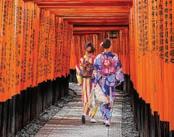
HawaiianMiles
A mile flown is a mile earned. HawaiianMiles members earn miles every time you fly with us to one of our many domestic and international destinations. Members can redeem those miles for flights, car rentals and more.
How to earn HawaiianMiles
Whether you’re traveling, out on the town, or on your computer, there are mileage earning opportunities everywhere. Earn HawaiianMiles with our airline, hotel, car rental, and shopping and dining partners. To learn about more ways to earn, visit HawaiianAirlines.com/HawaiianMiles/Earn
How to redeem HawaiianMiles
Use your miles to book flight awards with Hawaiian Airlines, our airline partners and more. Redeem your miles at HawaiianAirlines.com/HawaiianMiles/Redeem

Earn and redeem miles on partner airlines
Fly with our partner airlines and earn HawaiianMiles. Make sure your HawaiianMiles number is included with your reservation when booking or checking in with an agent. You can also redeem HawaiianMiles with our partner airlines to fly to exciting destinations for the vacation of a lifetime.
To learn more about our partnership programs, please visit HawaiianAirlines.com/HawaiianMiles

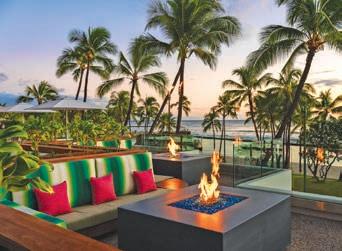

and start earning every day To join HawaiianMiles, visit HawaiianAirlines.com/Join/HanaHou or call 1-877-HA-MILES (426-4537) Earn HawaiianMiles on hotels worldwide Enjoy discounts at select hotels, resorts, condominiums and vacation rentals in your favorite destination. Book your accommodations at over 1 million properties worldwide and earn 1 HawaiianMile per dollar spent.* Visit HawaiianAirlines.com/Book/Hotels or call 1-844-762-0089. * Terms and conditions apply. Earn up to 2 HawaiianMiles per $1 spent at hotels participating in the Marriott Bonvoy portfolio including: The Ritz-Carlton® The Luxury Collection® Autograph Collection® Marriott Hotels® Marriott Vacation Club® Sheraton® Westin® and more. Visit HawaiianAirlines.com/HawaiianMiles/Partners Marriott Bonvoy™
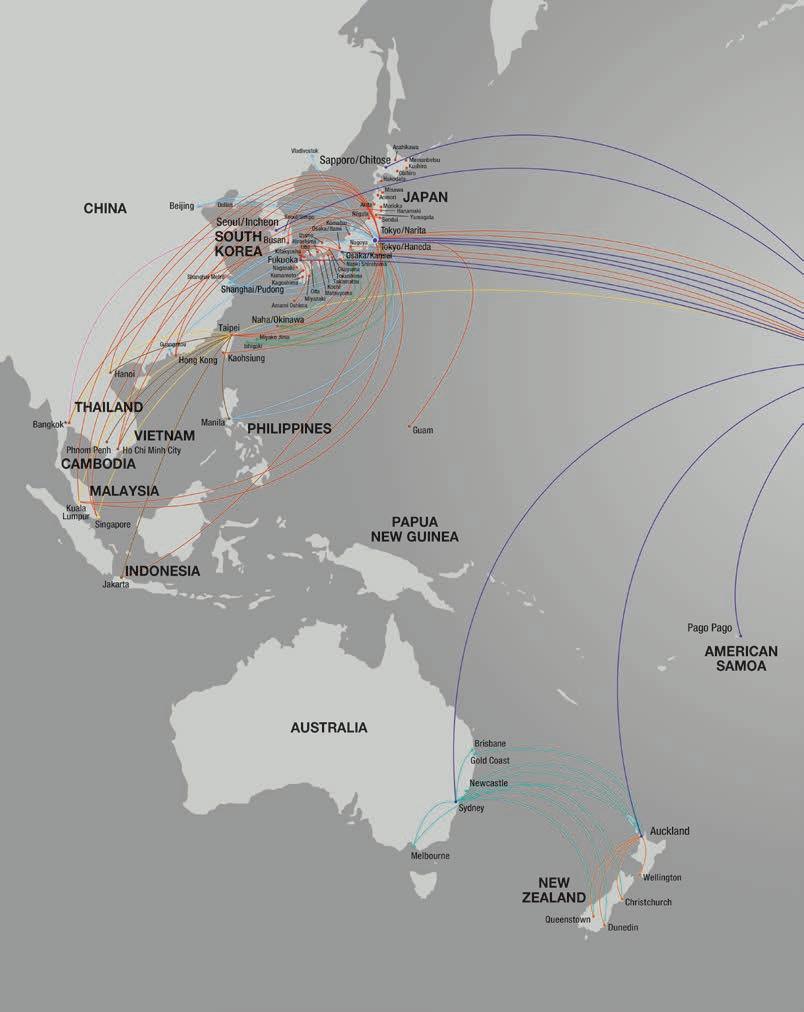
HAWAIIAN AIRLINES ROUTE MAP 136
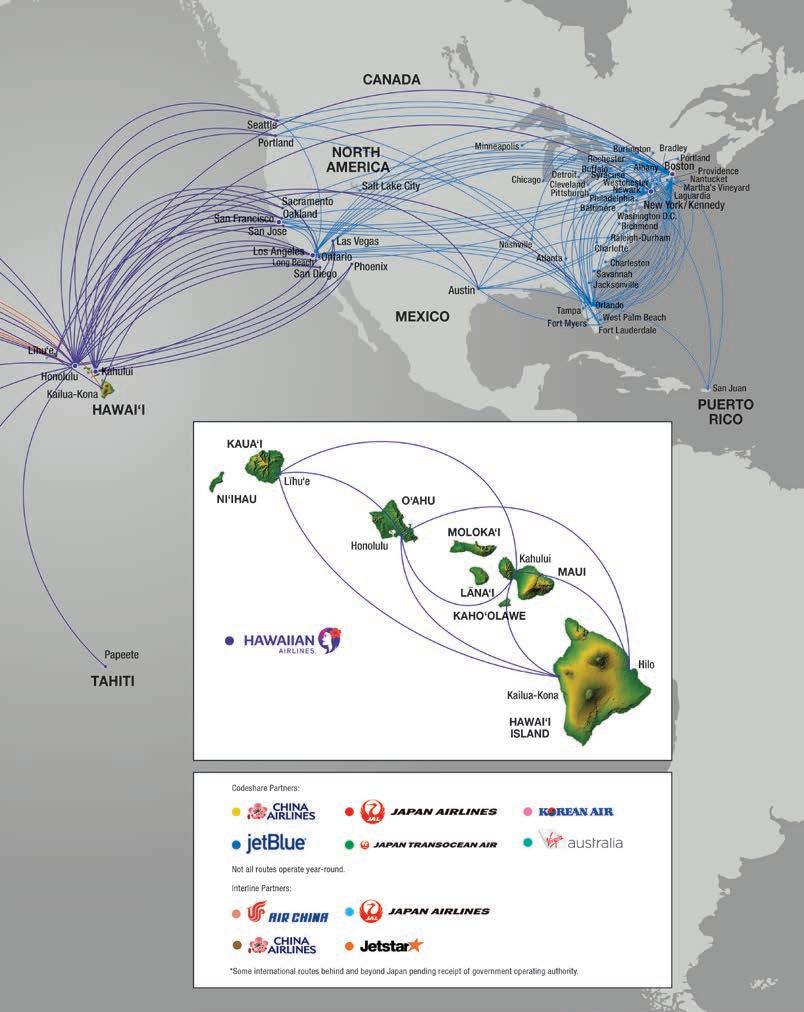
137
The ‘Ohana Pages

Plant the Planes
Every Hawaiian Airlines aircraft bears a name of cultural significance. Our short-range Boeing 717s are named after local birds, our long-haul Airbus A330s bear the names of stars or constellations used by Polynesian voyagers for celestial navigation and our mid-range Airbus A321neos are named after plants endemic to the Islands. Recently our employee volunteer cadre, Team Kōkua, joined forces with an alliance of public and private landowners—the Ko‘olau Mountain Watershed Partnership—to found a new restoration project called “Plant the Planes.”
“We started working with the Ko‘olau Mountain Watershed Partnership last year to support their efforts of repopulating native forests in O‘ahu’s
Ko‘olau mountain range,” said Debbie Nakanelua-Richards, director of community and cultural development at Hawaiian Airlines. “The work they do every day is humbling, and we are grateful for their support in transforming our Plant the Planes idea into a reality. This project is a testament to our shared dedication to mālama ‘āina (caring for the land) and restoring native habitats threatened by invasive species and climate change.”
Plant the Planes kicked off on Hawai‘i’s ‘Ōhi‘a Lehua Day (April 25) with seven Team Kōkua volunteers trekking up East Honolulu's Wiliwilinui ridge. The group cleared invasive strawberry guava and ironwood trees before transferring potted saplings into the ground, including twelve ‘ōhi‘a lehua trees, two maile vines and two ‘a‘ali‘i shrubs. They also dispersed
thousands of seeds for koa trees and Carex grass.
Nakanelua-Richards expects the restoration initiative to continue through 2023, with each project phase involving a new plant species featured in the names of our eighteen A321neo aircraft. “It is always meaningful when we come together to huli ka lima i lalo (turn our hands down) to do what’s pono (right),” she added. “As Hawai‘i’s hometown carrier, we know that our kuleana (responsibility) to protect our Islands— including incredibly remote places that most of us may never see or even know about—is monumental. We take great pride in our role in perpetuating what is unique to Hawai‘i for generations to come, from Hawaiian culture to flora and fauna that have called these Islands home since long before us.”
HAPPENINGS AT HAWAIIAN AIRLINES
138
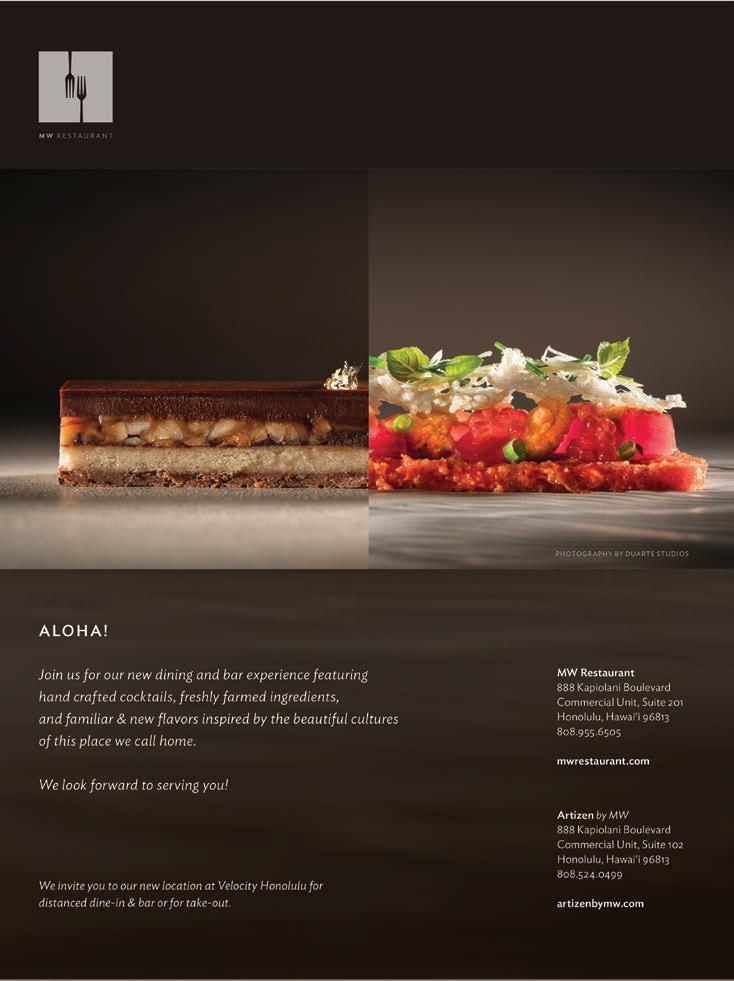
Long Live Ka‘upu
The ka‘upu (black-footed albatross) is an indigenous seabird known for being an accomplished flier and forming long-term pair bonds. It has called the Northwestern Hawaiian Islands home for thousands of years, but that habitat is under a growing threat. “Almost all of the ka‘upu in the world, about 28,000 pairs, nest on the low atolls of the Northwestern Hawaiian Islands,” says Eric VanderWerf, director of science at O‘ahu-based nonprofit Pacific Rim Conservation. “The biggest long-term threat to the species is the inundation of its breeding colonies by sea-level rise and storm waves caused by climate change.”
Pacific Rim Conservation is introducing the birds to a new prospective habitat on Isla Guadalupe, off the west coast of Mexico's Baja California Peninsula, which is already home to a thriving colony of mōlī (Laysan albatross). Over the past two years, Hawaiian Airlines has aided this effort by providing flight support for team members while also transporting ka‘upu chicks and eggs from Honolulu to San Diego on their way to Mexico.
“Ka‘upu are known to forage for food in the waters around Isla Guadalupe, but they historically did not nest there,” VanderWerf explains. “Some ka‘upu nesting in Hawai‘i fly to California and Mexico to find food and then fly all the way home to feed their chick. We can make that commute much shorter if we can get them to nest there.”
Online, Inflight
In April, Hawaiian Airlines became the first major airline to announce an agreement with Starlink to provide complimentary high-speed, low-latency broadband internet access to every guest on flights between Hawai‘i and the continental U.S, Asia and Oceania. The service will begin rolling out next year, and be available on Airbus A330 and A321neo aircraft, as well as our incoming fleet of Boeing 787-9s.
“When we launch with Starlink we will have the best connectivity experience available in the air,” said Hawaiian Airlines president and CEO Peter Ingram. “We waited until technology caught
up with our high standards for guest experience, but it will be worth the wait. Our guests can look forward to fast, seamless and free Wi-Fi to complement our award-winning onboard hospitality.”
Facing Future
In keeping with Hawaiian Airlines’ ongoing commitment to reduce its environmental footprint, the airline recently announced that it will invest in REGENT, an aerospace and maritime company building all-electric, zeroemission seagliders to provide harborto-harbor, overwater transportation. The airline’s strategic investment supports the initial design of a 100-person capacity, allelectric seaglider known as the Monarch. Hawaiian Airlines is REGENT’s first U.S.-based design partner for the Monarch, which is slated for entry into commercial service by 2028.
“Innovative interisland transportation has been core to our business since 1929, when we replaced steamships with airplanes. We are excited to be an early investor in REGENT and to be involved in developing their largest seaglider, which is a vehicle with great potential for Hawai‘i,” said Avi Mannis, chief marketing and communications officer at Hawaiian Airlines. “We look forward to working with REGENT to explore the technology and infrastructure needed to fulfill our vision for convenient, comfortable and environmentally sustainable interisland transportation.”

PREVIOUS PAGE / A section of O‘ahu’s Ko‘olau Mountains, near Kāne‘ohe
ABOVE / Scientists place transported Ka‘upu eggs into nests on Isla Guadalupe in January 2022. (Photo courtesy Pacific Rim Conservation)
BELOW / Starlink broadband internet will be available on select aircraft starting next year.

140 HAPPENINGS AT HAWAIIAN AIRLINES

Hawai‘i’s Wailele
(LEAPING WATERS)
ACROSS
1. Badmouth
5. Japanese dogs
11. Feeds the kitty
16. Dora’s squirrel friend
17. Solitary sorts
18. Japanese sports car
19. Old Māmalahoa Highway sight
21. Felonious fire
22. Pari ___ (at an equal rate): Lat.
23. Maui or Kaua‘i: Abbr.
24. Pre-Christmas period
25. Fragrant compounds
27. Lychee fruit covering
30. African fox
31. High schoolers, mostly
34. A king of Moab
36. Mrs. who met a ghost
39. Wailuku River State Park sight
44. “Er ... um ...”
46. 51A abbreviation
47. Ump’s peer
48. Abbr. for a handyman
49. Wrist bone
51. Airport west of Oakland, CA
53. Jackson Hole range
55. Henri’s soul
56. Morrison or Heflin
58. “Am ___!”
60. Put in fresh soil, perhaps
61. Waipi‘o valley sight
65. Sauciness
66. Covergirl rival
67. Ages and ages
69. Refrain syllables
72. She threw the apple of discord
74. Classic Volkswagen
78. Tin Man’s first request
80. All’s fair in it
83. ___ Gold
84. Hawai‘i environs
85. Hawai‘i Tropical Botanical Garden sight
88. Julia and Ramirez
89. 87D rival
90. Fish story, e.g.
91. Architectural pillars
92. Response to 58A 93. Important ages
1. Simpleton, in slang 2. Succotash beans 3. “... with ___ of thousands!” 4. Kids’ cheesy board game 5. Hawaiian way 6. Annan of the United Nations 7. Actresses Balin and Claire 8. “Don’t ___ soul!”
. Humane org.
. Serpent sound
. Diary of ___ Black
. Kurt Cobain’s band
. Zaps
. Schoolboy jackets
. Word in a French toast
. Wall in, old style
. Dead wrong
Church chat: abbr.
. 1860s soldier, briefly
. Dr. Frankenstein’s aide
Highland denial
. Poses for a portrait
. Figure for negotiation
. Bible book after Jonah
. Savory taste
. Center of a wellknown palindrome
. ’90s treaty acronym
. Drug for Parkinson’s patients
. Floor coverings, to a Brit
. Networks: abbr.
. Warship-related
. Wyatt and Bat
. Be audibly sad
. Cinq et quatre 69. Irish lullaby opener 70. Puerto ___ 71. Alaska native
73. Talked a blue streak?
75. Tissue-related
. Alley Oop’s gal 54. Checkered 57. Close at hand 59. Barcelona bravo 62. Milan music mecca 63. “By the way...”: Abbr.
76. Female ’70s F1 racer ___ Lombardi
77. Hāna Highway curves
79. Handle for Henri
81. African tyrant
82. Nevada’s “Biggest Little City”
85. Barcelona bruin
86. All Things Considered network: Abbr.
87. Ma Bell
142
Crossword
10
13
14
15
20
24
26
28
29
32
33
35
36
37
38
40
41
42
43
45
50
52
DOWN
9
11
Woman 12
.
.
64
68


Earn after first purchase * 70,000 bonus HawaiianMiles® First checked bag free One-time 50%-off companion discount Annual $100 companion discount Ask your flight attendant for an application.* Special in-flight offer is available through the in-flight application. *Offers may vary. Terms apply. See your flight attendant for an application with more information about this offer. The Hawaiian Airlines® Bank of Hawaii World Elite Mastercard® is issued by Barclays Bank Delaware (Barclays) pursuant to a license by Mastercard International Incorporated. Mastercard, World Mastercard and World Elite Mastercard are registered trademarks, and the circles design is a trademark of Mastercard International Incorporated. © 2022 Barclays Bank Delaware, PO Box 8801, Wilmington, DE 19801, Member FDIC. Earn even more miles through HawaiianMiles® Partners. Visit Partners.HawaiianAirlines.com to learn how to earn bonus miles at thousands of locations nationwide. HAWAIIANMILES ON GAS, DINING AND ELIGIBLE GROCERY STORE PURCHASES HAWAIIANMILES ON ELIGIBLE HAWAIIAN AIRLINES PURCHASES HAWAIIANMILES ON ALL OTHER PURCHASES
“I want to inspire people to fall in love with surfing,” says Jamie O’Brien. “Whether it’s through a surf school or being a YouTuber who surfs the gnarliest waves on the planet. That’s what it’s all about.”

When I told my kids that we were maybe going to meet Jamie O’Brien in a couple days, their response was unsurprising: My son just stood there with his mouth open; my daughter was only slightly more composed, letting loose a couple pirategrade expletives before jumping on her phone to spread the news. My kids are early-stage surfers, and throughout their young lives we’ve regularly made the trek from town up to the North Shore to watch the action at Pipeline and its wicked sibling, Backdoor. These are among the world’s most dangerous waves, and O’Brien is among the best to ever ride them. But this is not the sole reason for my kids’ outsize reactions, nor are they alone: Ask a teenager in, say, Minnesota’s Mall of America to name some surfers and the short list might include Duke Kahanamoku, Kelly Slater and Bethany Hamilton. But it would definitely include Jamie O’Brien.
It takes a rare type of surfer to cross into mainstream consciousness, and when they do, it’s not always for the best
reason: Slater, an eleven-time world champion, initially became a household name in the mid-1990s not so much for his insane surfing ability as for his role as Jimmy Slade on Baywatch O’Brien, on the other hand, is famous for being himself: a “freesurfer” whose talent and media savvy have not only liberated him from competing on the professional circuit but also earned him the latitude to have a little fu n— actually, a lot of fun. He is likely the only surfer in the world—well, he and his co-conspirators—who can get away with paddling out at Pipeline wearing only a too-tight Speedo. This knack for being unserious in the most serious of situations has earned his YouTube channel nearly eight hundred thousand subscribers and exponentially more viewers for the “JOB Vlogs” he posts there: At last count, “I Almost Died at Pipeline” (spoiler alert: head trauma) had 1.7 million views; “Storm Drain Surfing”—which includes a harrowing group ride down a near-vertical concrete culvert on a giant, inflatable flamingo— had more than 27 million.
Most recently O’Brien co-founded the Jamie O’Brien Experience, a surfing school at Turtle Bay Resort, with Kaikea Elias, who’s been appearing online with O’Brien since the beginning. “Jamie and I wanted to start a surf school for at least the last ten years,” says Kaikea. “But Turtle Bay was the only place we wanted to do it, because it is the only surf break in the state that allows a single commercial license.” All of Hawai‘i’s surf breaks are public property, but the advantage to Turtle Bay is that the few North Shore locals who surf there are, often as not, the same locals who teach at the Surf Experience, which employs a mix of upand-coming pros and established veterans. O’Brien himself isn’t on the teaching roster at the school, though he tries to show up at least a couple times a week when he’s not traveling or filming, and will just hang or surf with whoever happens to be there. The day before our visit, he’d broken a toe while filming on a dirt bike, but he paddled out anyway. In between talking up the kids and pushing them into some of the best waves of their lives, he and Elias hatched plans to film during a huge swell that was on its way up from Tahiti. At one point while both kids were making their way back out to the lineup, an overhead set approached. O’Brien gave a hoot and flipped his hot-pink longboard around to take off, fins first. Sitting on the wave’s shoulder, I watched as he pulled into the tube, board backward, broken toe and all. He ate it and came up laughing, which brought to mind something he’d told me earlier when asked if he’d ever envisioned this life for himself.
“It’s pretty crazy how it worked out, but I’m just doing me: Yes, this is a business, but whether it’s the surf school or the videos, I just want to give people the same thing that my father gave me. Sur fing kept me off the streets, it kept me away from drugs, it kept me in a beautiful place and that’s why it is so loved: Everyone who goes surfing just feels like they win.” hh
STORY BY STU DAWRS PHOTO BY ARTO SAARI PAU HANA School of Stoke
144











 THE FIXERS / An integral part of Hawai‘i, they step in when "Mickey Mouse repairs" to watercraft won't do.
B-BOYS / Breakdancing is making a comeback in the Islands. Meet the crews.
ALOHA GOES BOTH WAYS / A video series exploring locals who embody the aloha spirit both at home and afar.
THE FIXERS / An integral part of Hawai‘i, they step in when "Mickey Mouse repairs" to watercraft won't do.
B-BOYS / Breakdancing is making a comeback in the Islands. Meet the crews.
ALOHA GOES BOTH WAYS / A video series exploring locals who embody the aloha spirit both at home and afar.















 STORY BY MARTHA CHENG
STORY BY MARTHA CHENG

 STORY BY MARTHA CHENG
BY TOMMY SHIH
STORY BY MARTHA CHENG
BY TOMMY SHIH


 STORY BY MEGHAN MINER MURRAY
STORY BY MEGHAN MINER MURRAY
























 PHOTO COURTESY DEREK HAMASAKI
PHOTO COURTESY DEREK HAMASAKI





 STORY BY PETER VON BUOL
STORY BY PETER VON BUOL



































































































































































